Railay Beach (aka Rai Leh, aka Krabi). What can I say, it’s paradise. Or at least it can be…with the right information.
Lori and I have so far visited twice over the span of a decade—spending about a week at a time in Railay.
Sure, there’s been some changes (particularly with regards to budget accommodation), but Railay’s also become more accessible with more dining options. Pros and cons.
Here’s our first-hand guide for travelers—including our top picks for things to see and do, tips from our own experience, and our honest opinion about the place.
Planning a Visit to Railay Beach?
Here are our hand-picked recommendations for where to stay:
✪ Best of the Best Rayavadee
✪ Mid-Range BeachFront Sand Sea Resort
AND…our Railay top tour recommendation:
✪ Top-Rated Hong Islands Day Trip
This post contains affiliate links. If you click and make a purchase, we might receive a commission (at no added cost to you). Thanks for supporting independent, ad-free blogs!
Why Visit
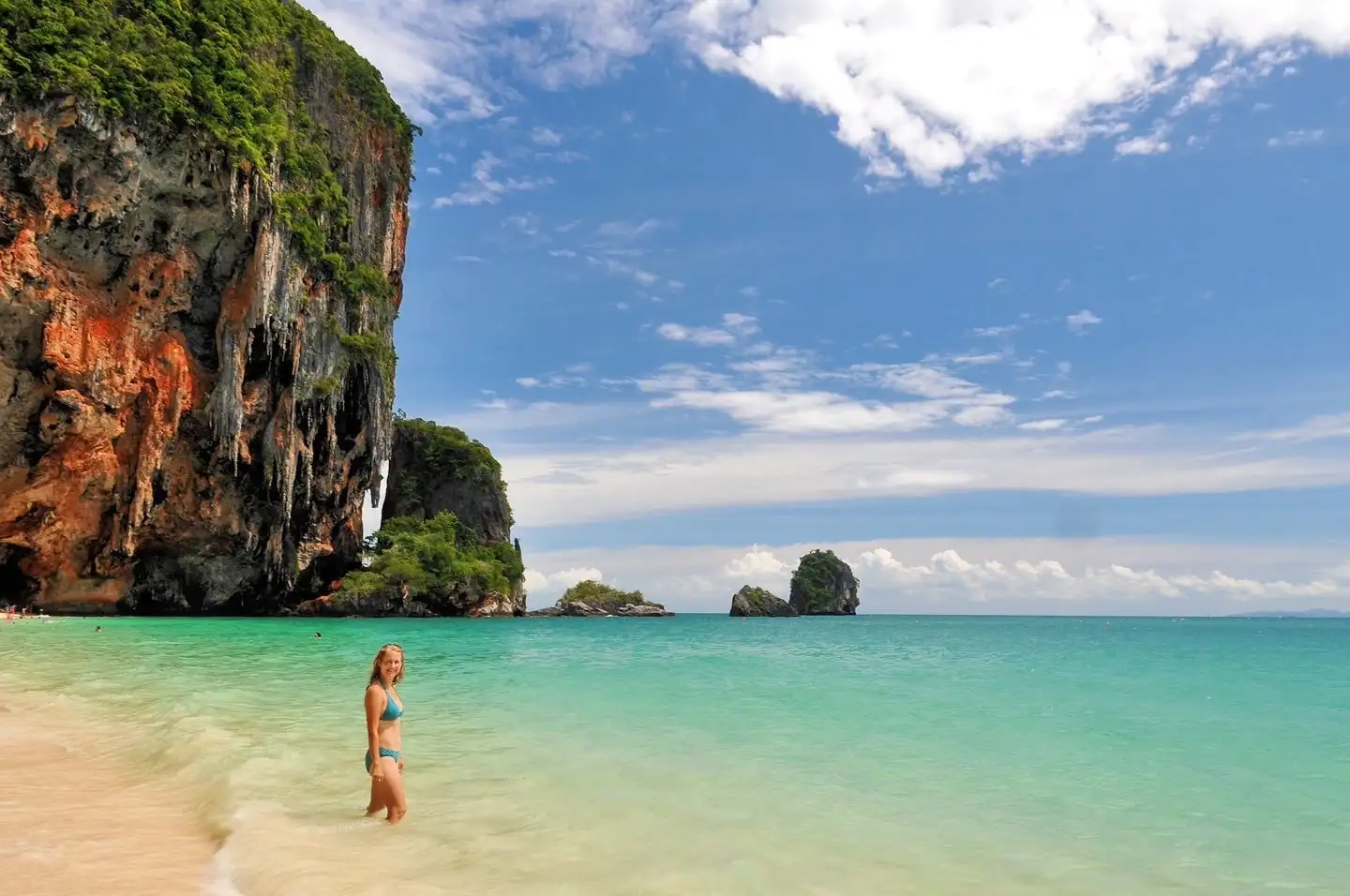
Raiiilay, mawn. I don’t use the word magical very often, but this place is just that, magical.
If you go to Thailand and head down south to the Andaman beaches, don’t be lame and base yourself out of Ao Nang, Phuket or Phi Phi (where EVERYBODY stays)—without visiting Railay.
That’s not why you came 5,000 or even 10,000 miles to this stunning part of the world, right?
Make your way to the Railay peninsula and anchor yourself there for a few days. There’s more to see and do than you’ll have time for, and you can always take a day boat trip to Phi Phi, Ao Nang or any place else in the area.
If you do happen to run out of things to do in Railay, GREAT! That’s the point after all, isn’t it?
You suddenly find yourself on one of the most beautiful beaches anywhere in an isolated beach village only accessible by boat (no roads, no cars, no planes) but with all the amenities you could hope for for travelers on every conceivable budget.
Introduction
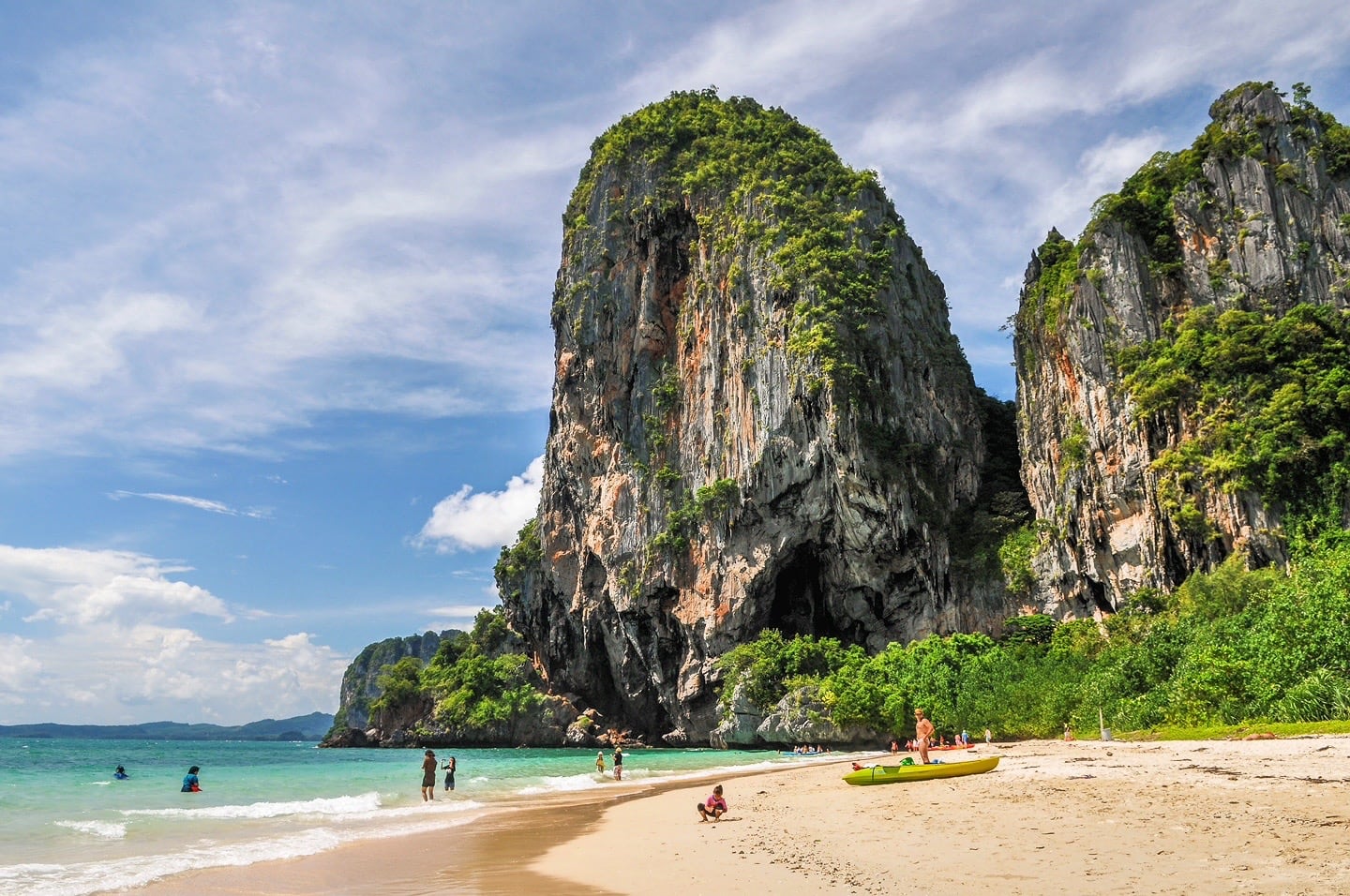
Travelers often call this area by the provincial name, Krabi, but this can refer to a lot of places within Krabi Province including Ao Nang, the major beach in Krabi, and Krabi Town—neither of which are Railay.
Railay is a rocky peninsula comprised of towering limestone peaks edged by white sands. Although the peninsula is connected to the mainland, it is cut-off from other towns by land due to the sheer karst cliffs that make up the northern boundary of the area.
There are no roads in and out of the area and thus all people and goods must be brought in by boat as they would be to an island.
In recent decades, Railay has become a mecca for climbers, given its sheer limestone cliffs and stunning scenery. However, the belief that climbing is front and center and the peninsula is swarming with climbers is a bit of a misconception.
Granted, we didn’t stay on the more remote and lesser frequented Tonsai Beach (reputed to be the preferred choice of young laid back rasta-lovin’ climber-travelers), but we were hard-pressed on most parts of Railay to find much of a climbing culture.
Of course there is climbing going on on a daily basis at a handful of key spots, but the culture isn’t akin to, say, Koh Tao’s SCUBA culture, where nearly everything on Sairee Beach is permeated by diving—the talk, the dress, names of bars and resorts, etc.
We’ve found much of Railay to be more upmarket with an older clientele than we might have thought. But you can still find plenty of pockets of young people and the party is never too far away if you’re looking for it.
Something else that I don’t think is properly conveyed by travel guides is the crunch of day trippers that descend on Railay. Most days, we were able to avoid the 10a-3p rush hanging out at our cabana or going on a day trip ourselves.
Railay also has some nice hikes away from the crowds if you’re up for a little adventure.
Railay Beaches
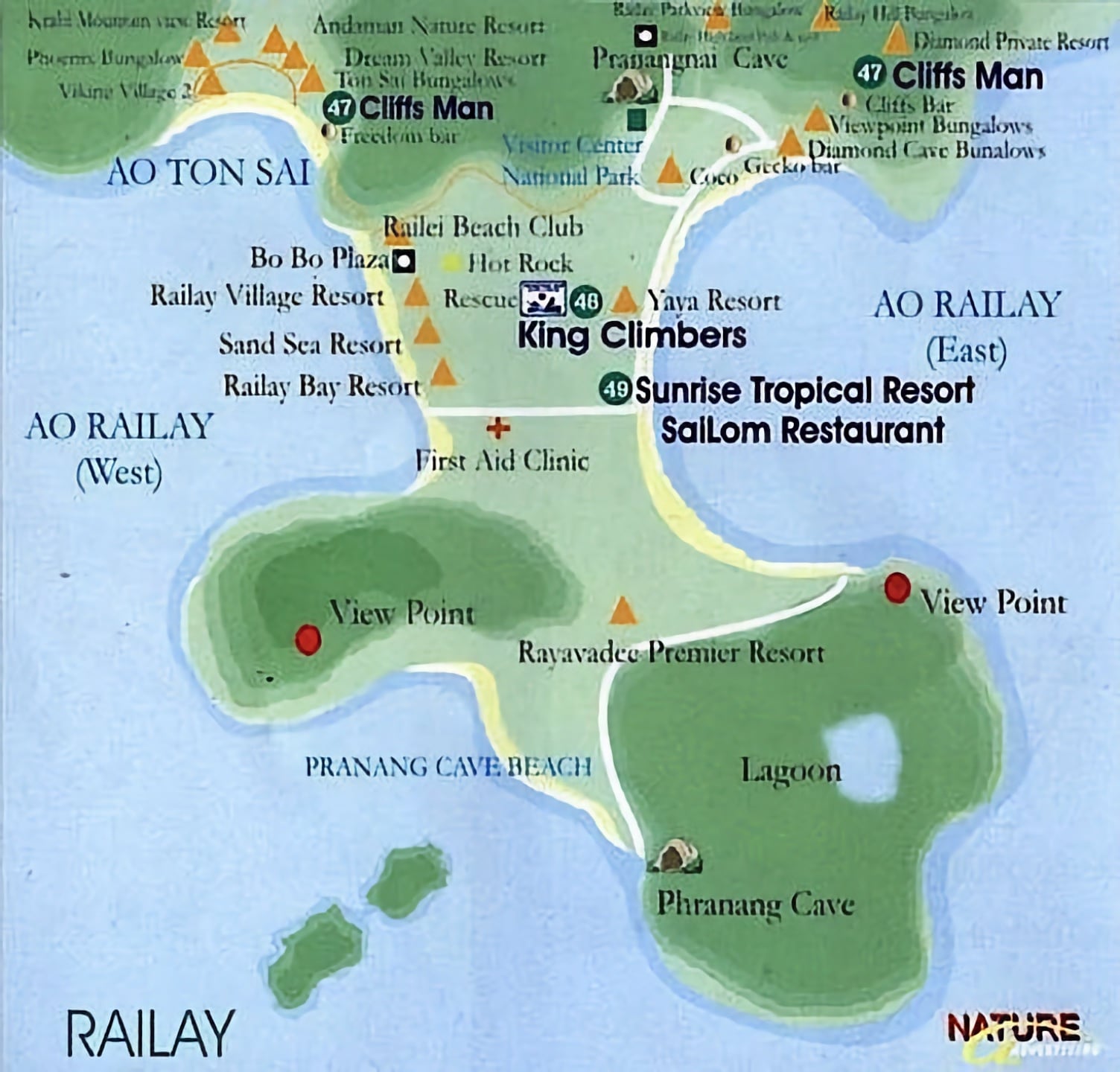
There are four main beaches around the peninsula, each offering a unique vibe all their own: Railay East, Phra Nang (Princess) Beach, Railay West, and Ton Sai.
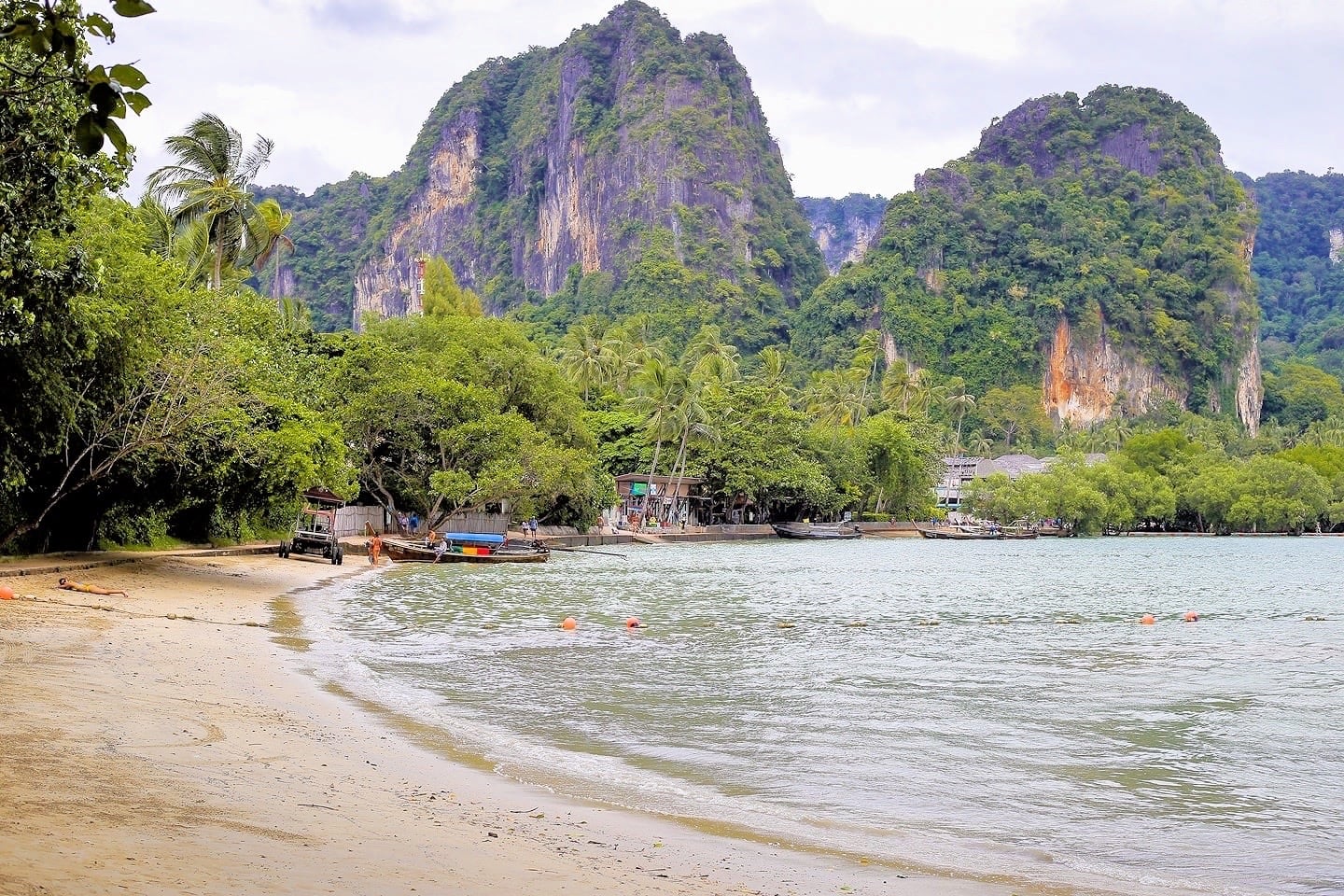
Railay East
Railay East is a picturesque stretch of mangrove (though the mangroves are slowly disappearing due to development).
This is the point of entry for those taking the boat from Krabi Town 20-45 minutes to the east.
At the northern end of Railay East, there is a large enclave of budget restaurants and bars. Beyond this lies the area known as the highlands (or headlands as written by some).
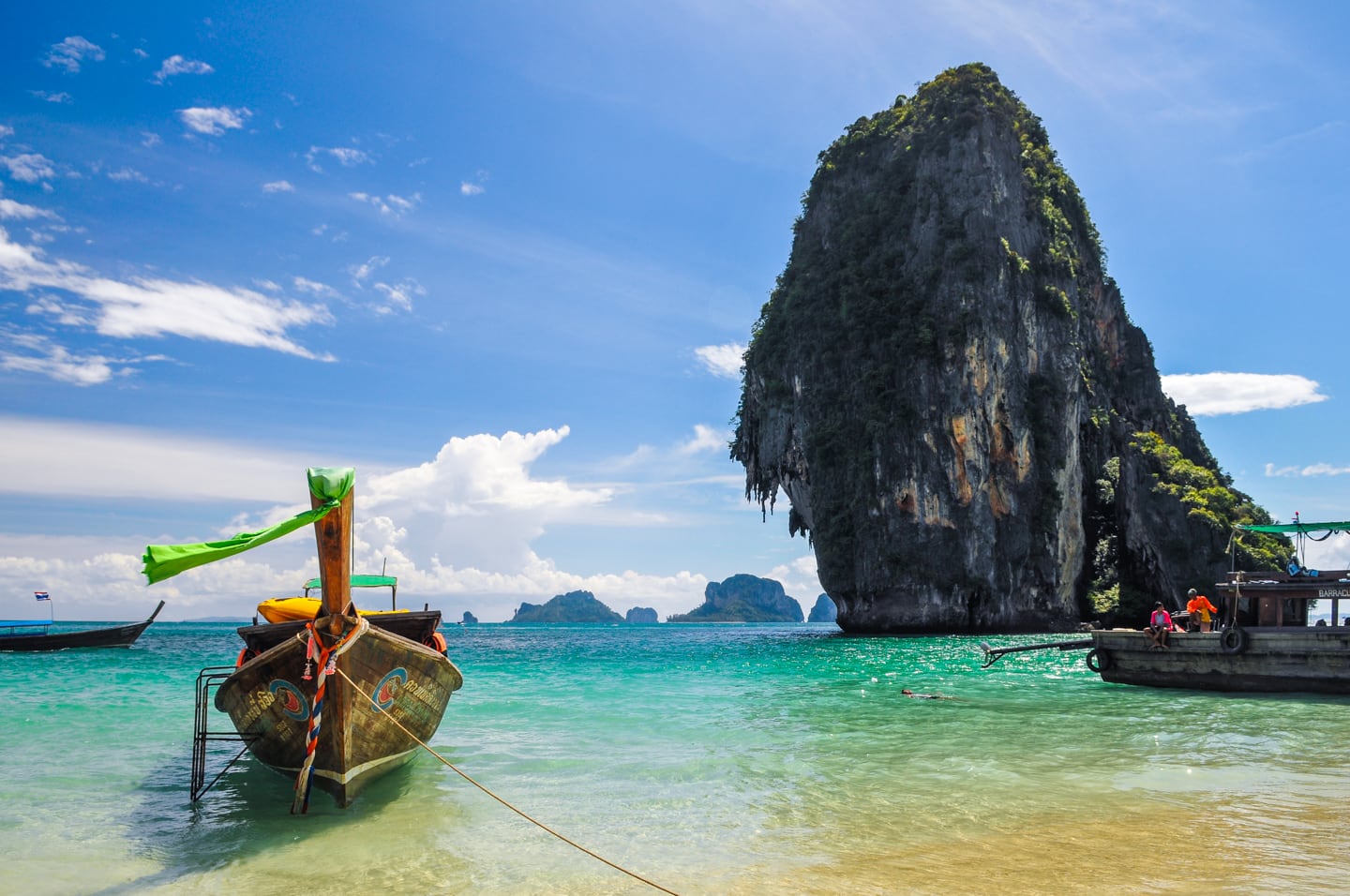
Phra Nang (Princess Beach)
Moving clockwise around the peninsula is Phra Nang (Princess Beach), Railay’s best beach and arguably one of the best in Thailand. It’s truly an awesome beach. Fine sand, turquoise water, and striking limestone rock formations.
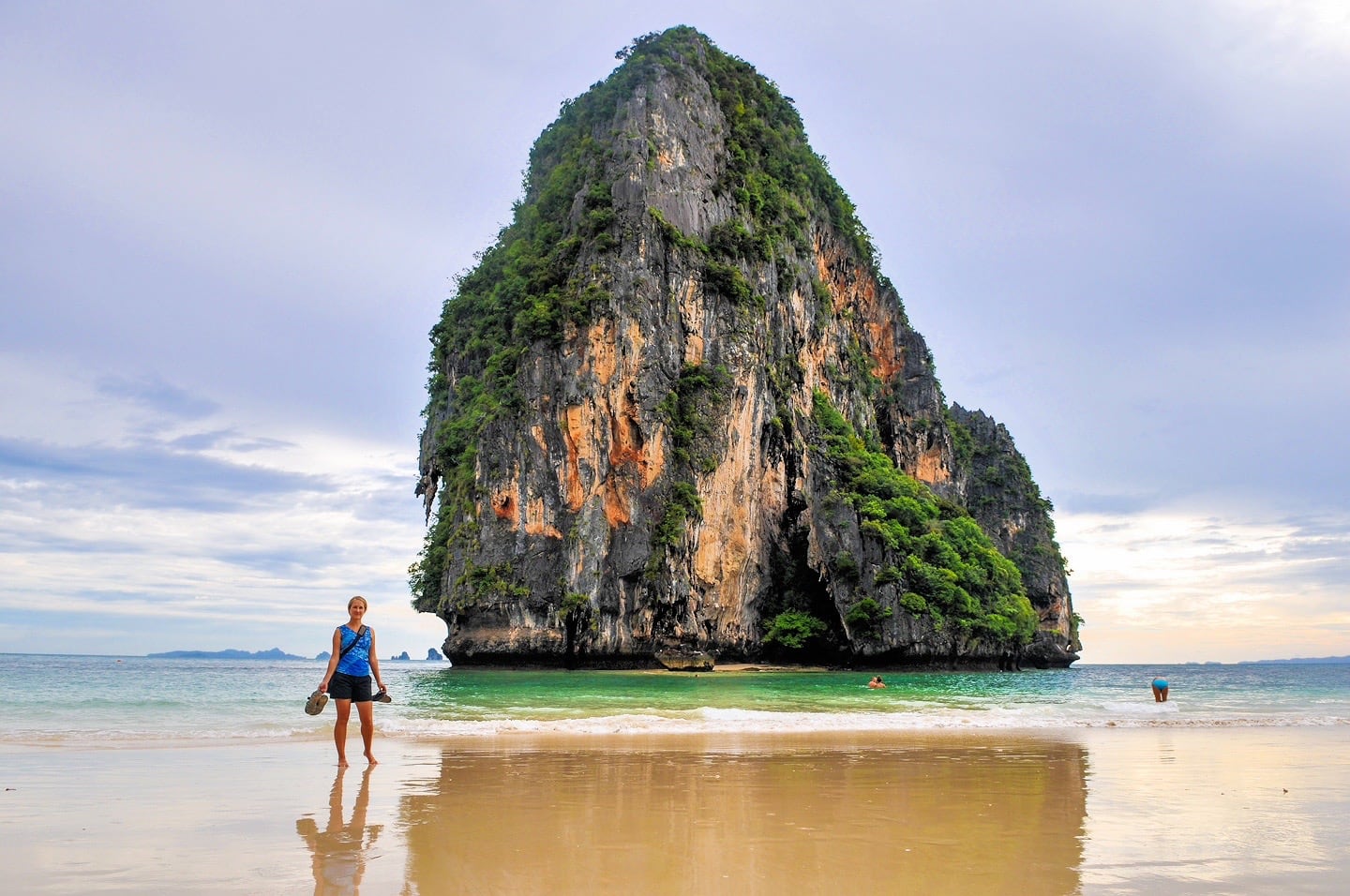
You’ve got swimming, kayaking, cliff-jumping (people do it off the rock on the far eastern edge into an area marked by buoys), rock climbing, not to mention the cave through the mountain to the other side that’s worth exploring.
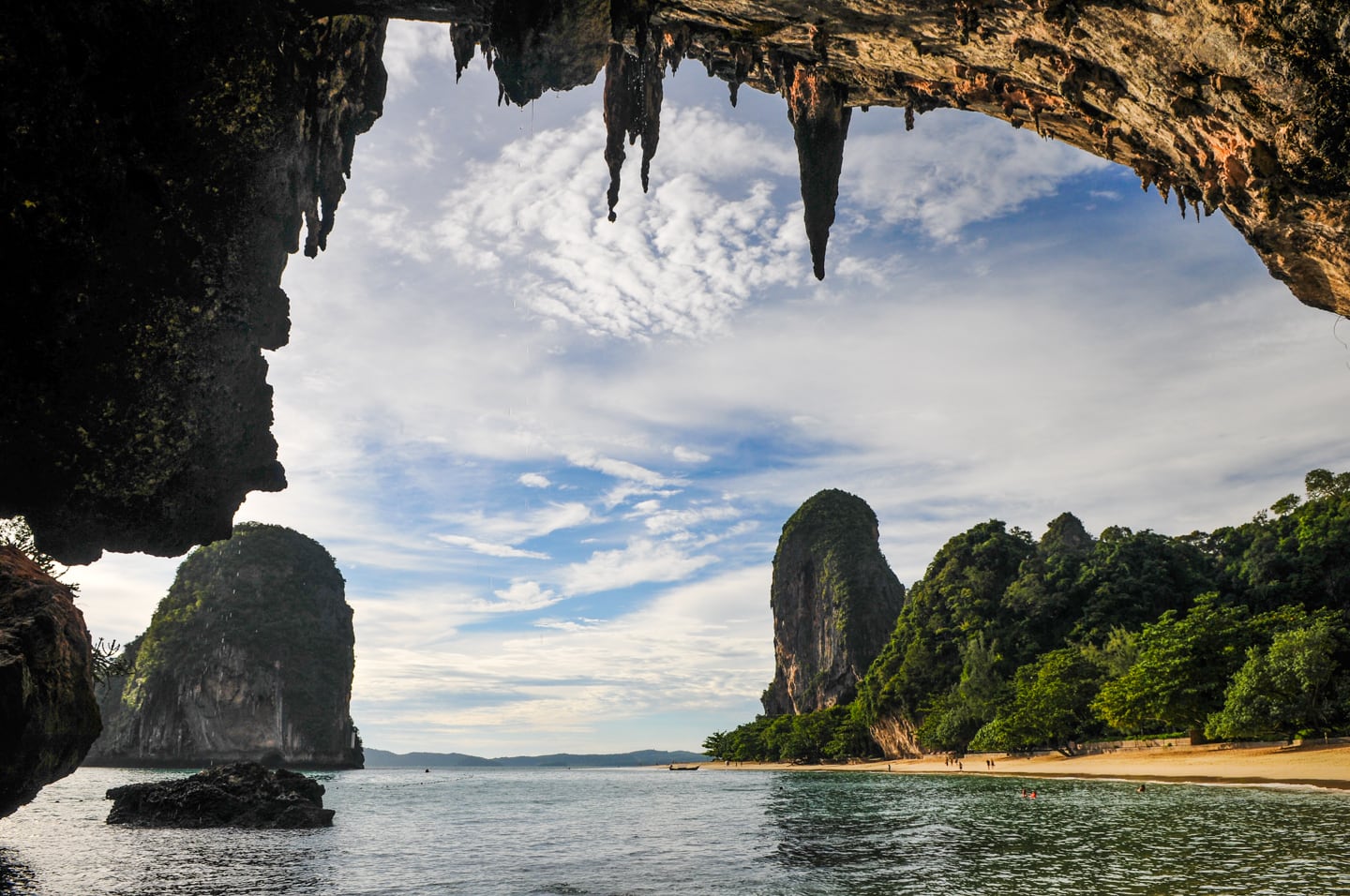
From 10am to 3pm, Phra Nang is over-run by dozens of longtail and speedboats bringing hundreds of day-trippers to the beach—Phra Nang Cave (at the southern end of the beach) is a popular stop on many boat tours of the area.
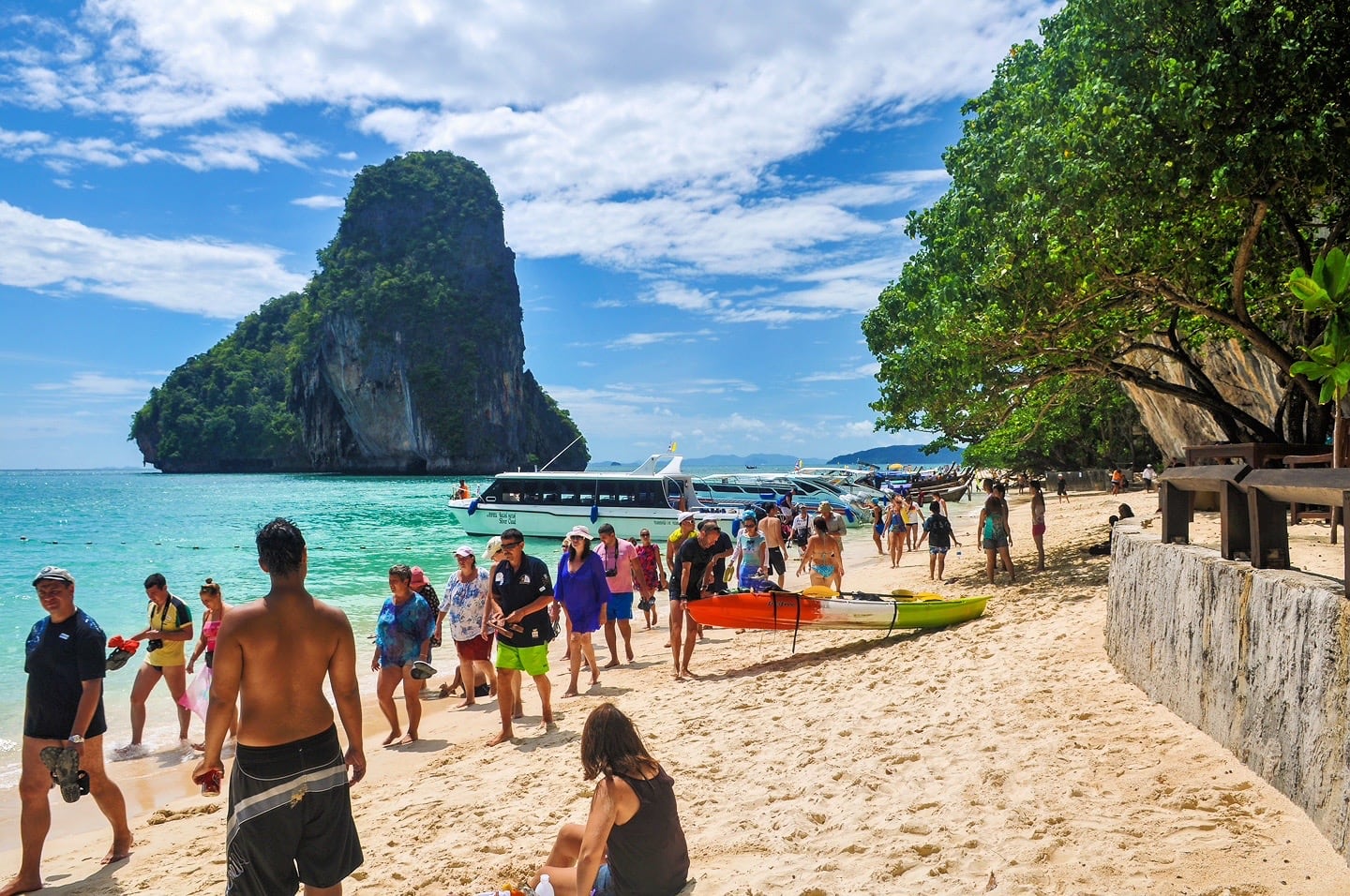
Phra Nang Cave is packed with carved wooden phalluses of all shapes and sizes and offerings to a princess believed to have drowned near here (there’s a whole story as you might expect).
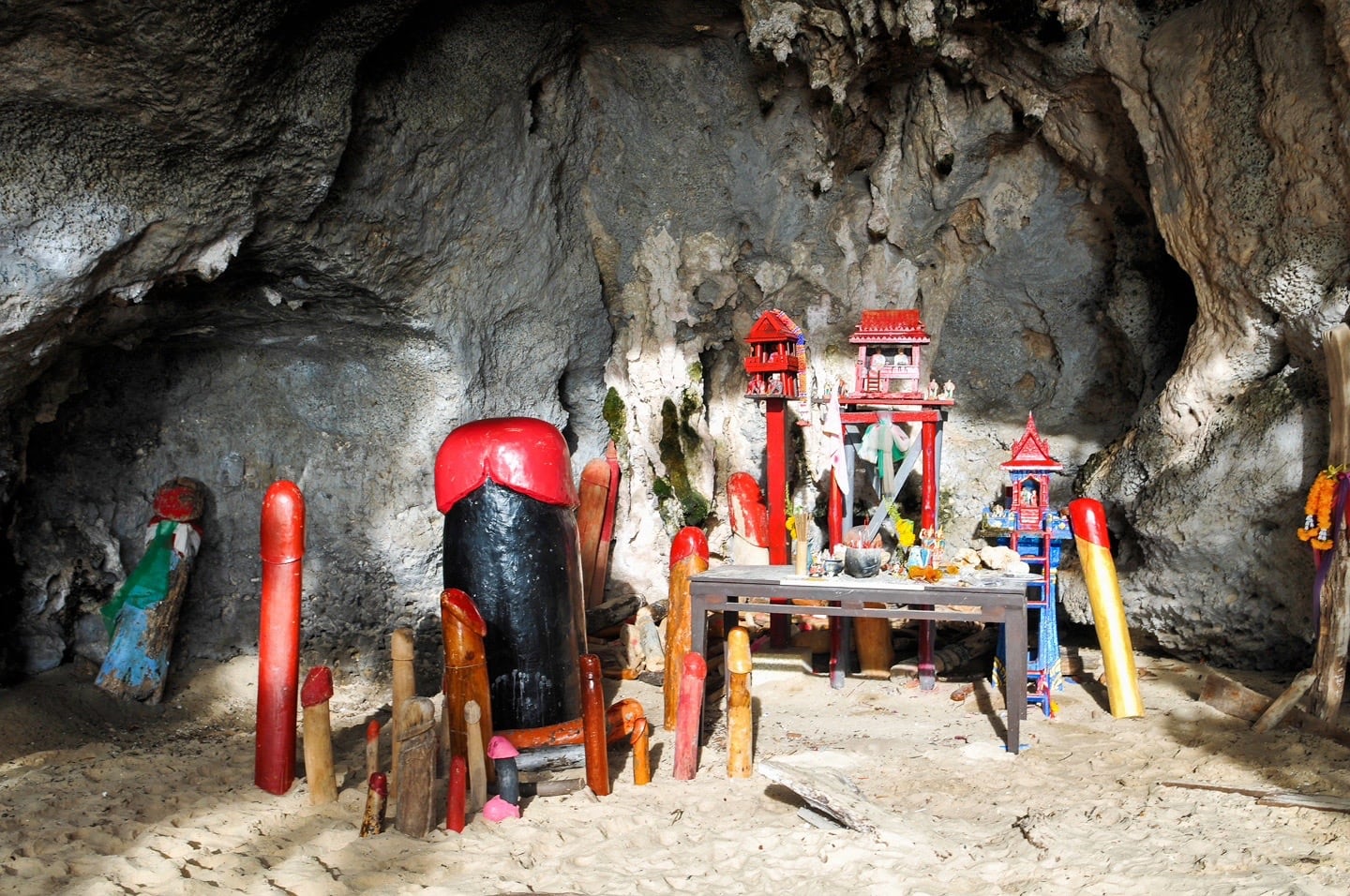
Oh, and did I mention this beach is teeming with snack-snatching monkeys! Keep a close eye on all of your possessions. Seriously—they descend from the trees ninja-style and will take whatever they can get their grubbies on.
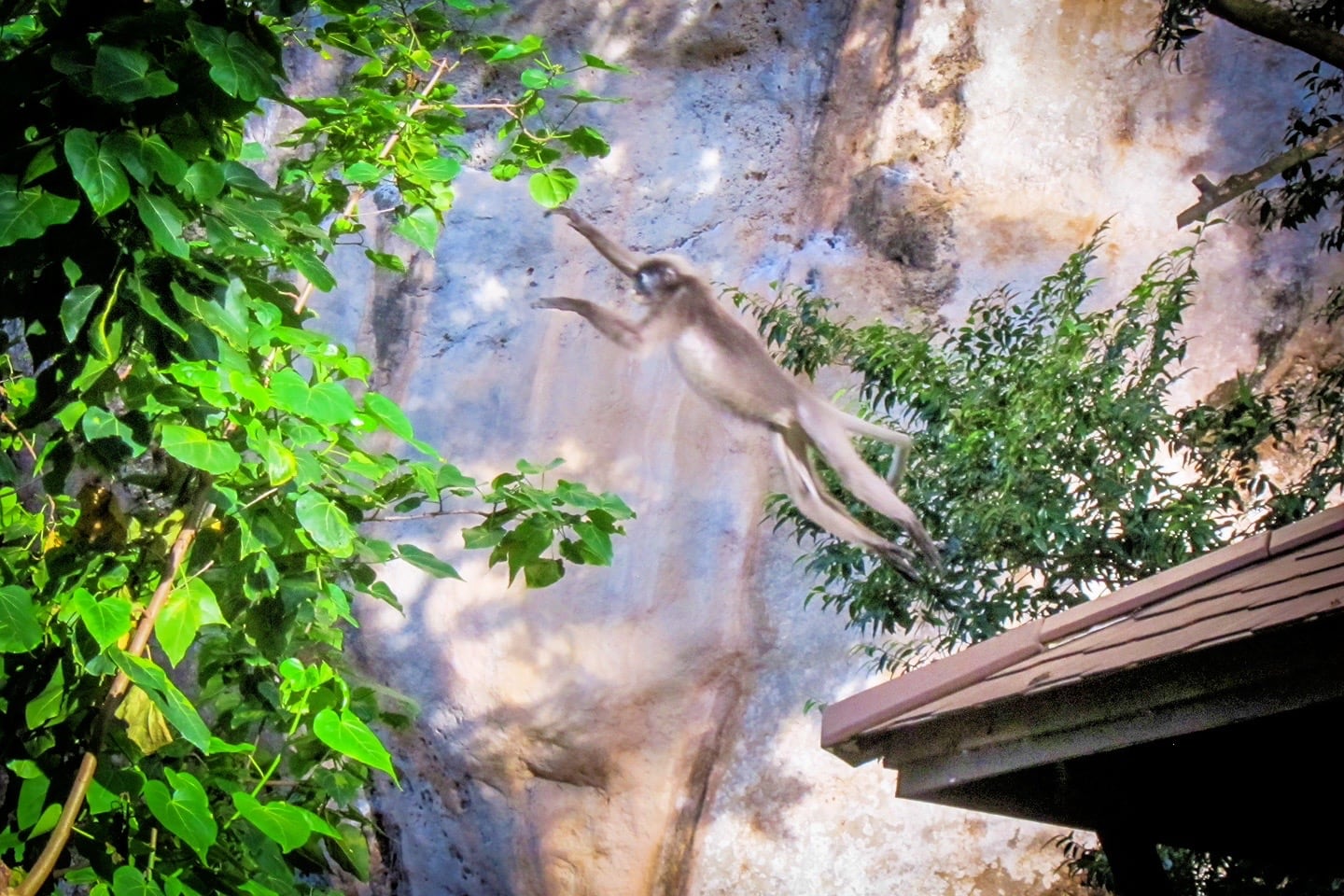
The number of people on Phra Nang can be overwhelming during the day, but if you’re staying on Railay, after 4pm the beach usually empties out (outside of high season, that is).
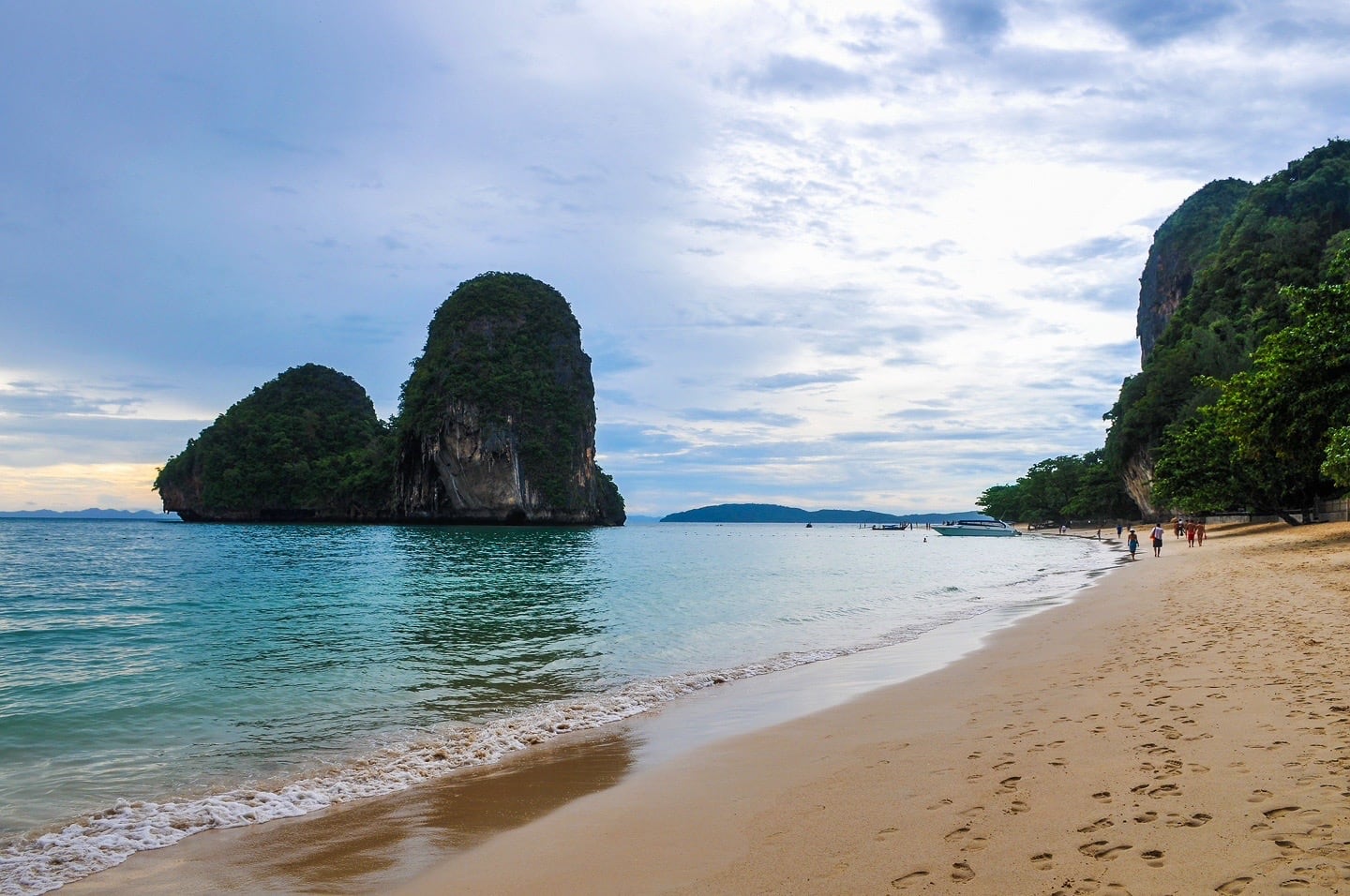
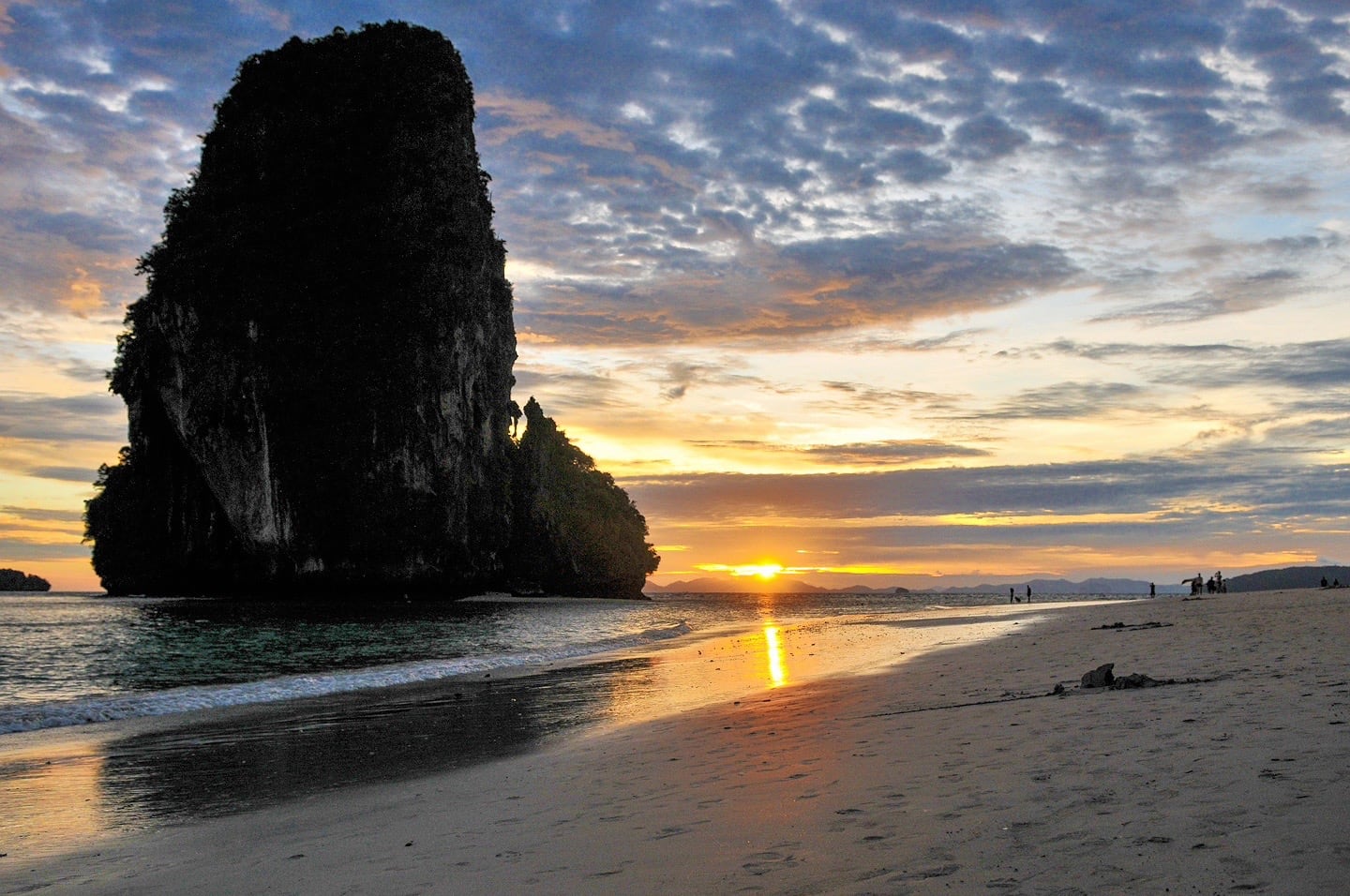
Needless to say, we spent a few evenings watching the sunset on Phra Nang.
There aren’t really many services on this beach, save for the luxury eco-resort, Rayavadee, which runs the length of the beach. Tastefully incorporated into the natural surroundings, Rayavadee offers two restaurants and a cafe, but their prices, as you can imagine, are steeper than most other places on the peninsula.
Lori and I are perfectly content with packing in our own sundowners. We got two Leo beers from the nearby minimart on southern Railay East, but FAR better deals can be had in the half dozen or so mini markets interspersed among the budget restaurant quarter at the northern end of Railay East…just FYI.
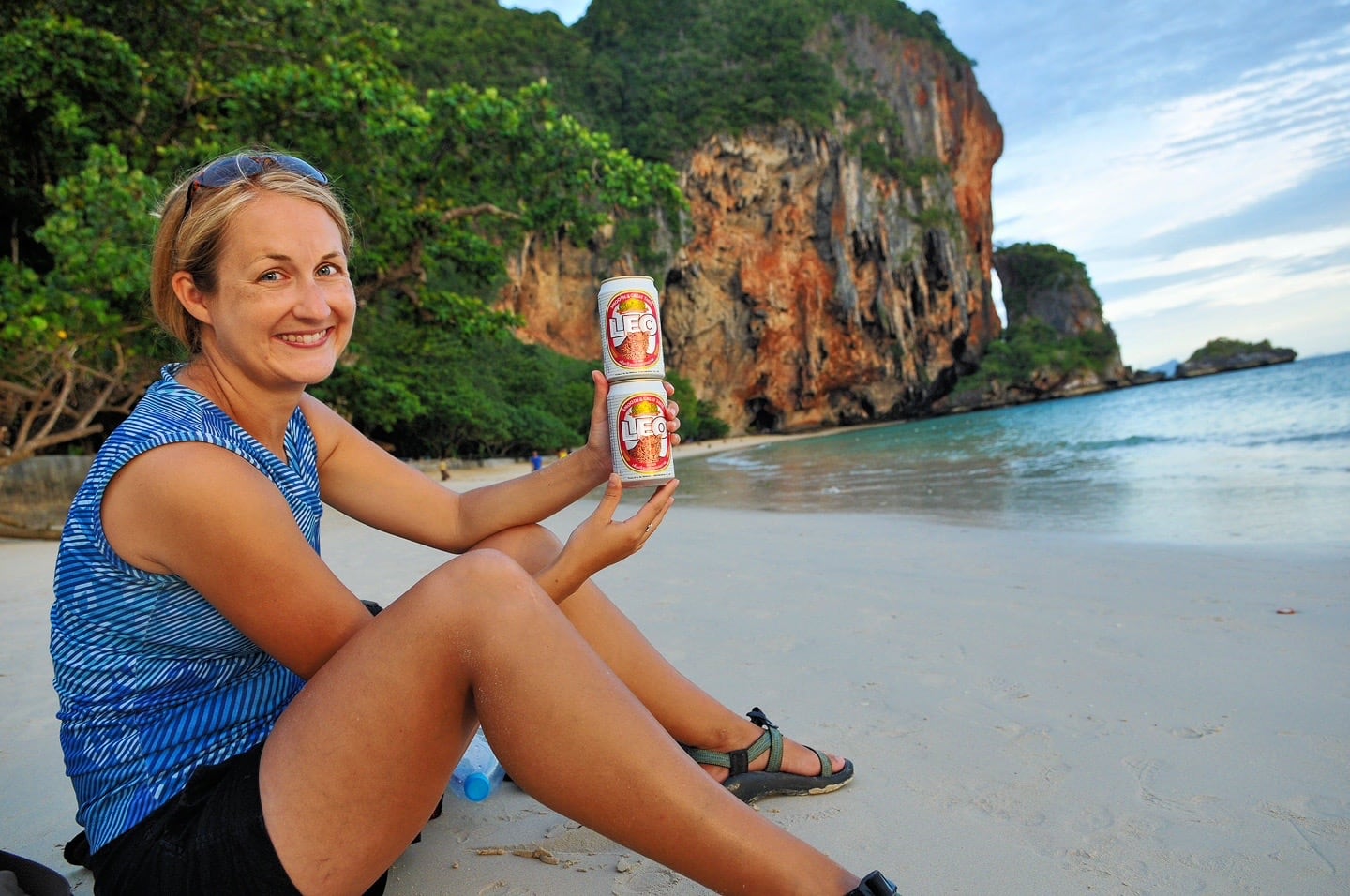
Phra Nang is accessed via a paved path which takes you through various cave mouths and monkey territory (there are dozens of macaques here in the evenings—watch your sunglasses and other belongings!).
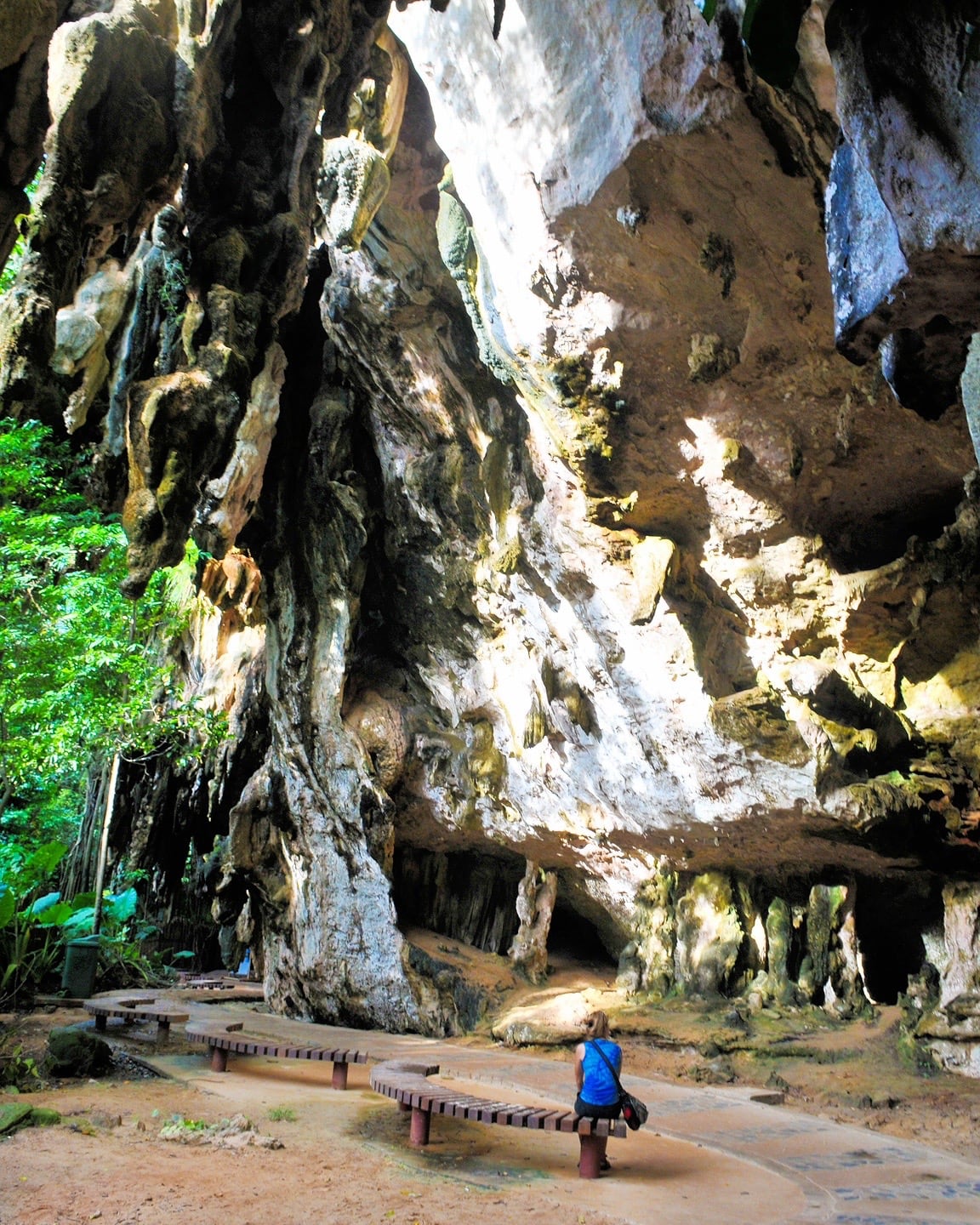

Railay West
North of Phra Nang is Railay West beach, the largest swimming beach on Railay where most of the development efforts have been focussed. Most day trips to Ao Nang or Koh Phi Phi depart from Railay West.
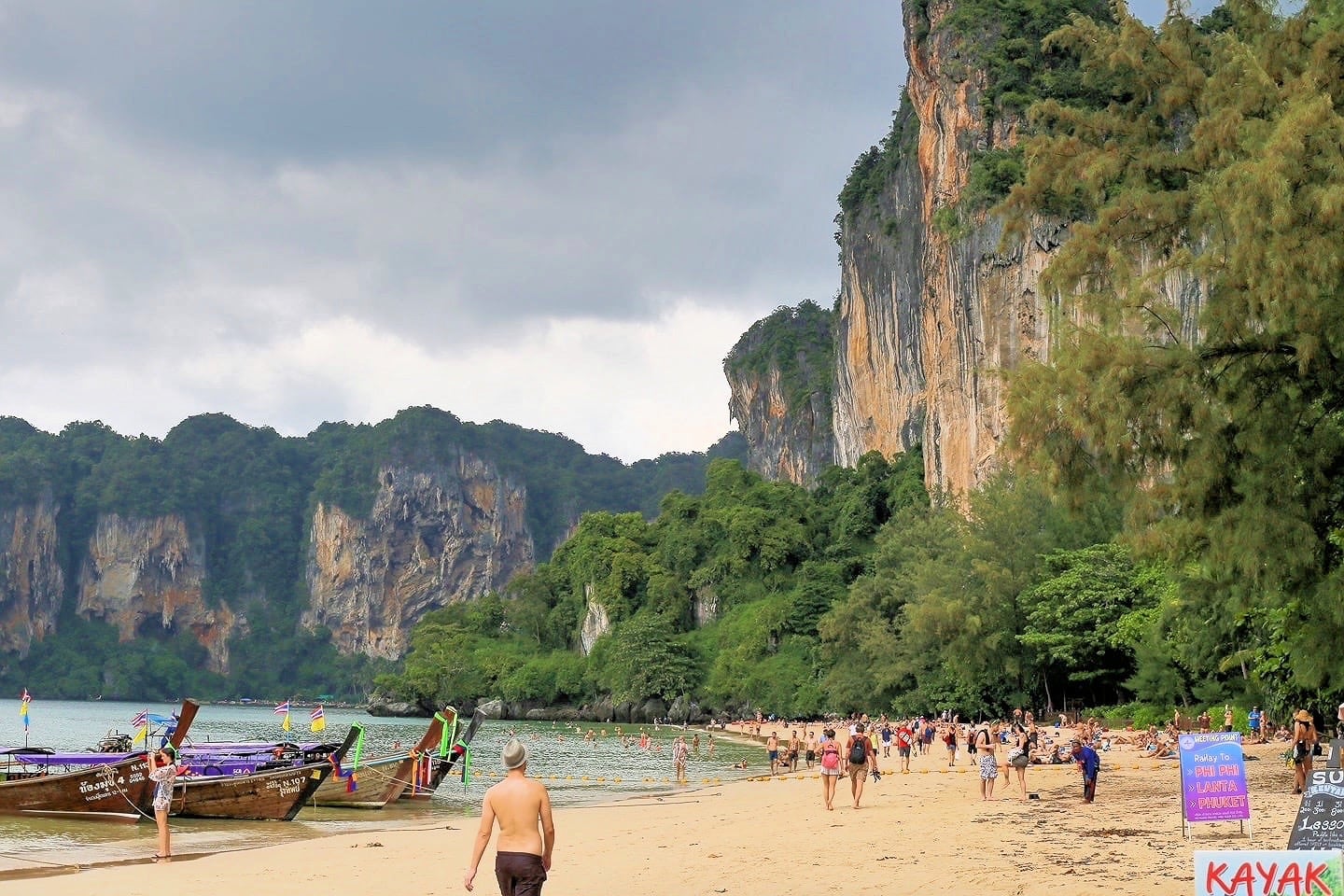
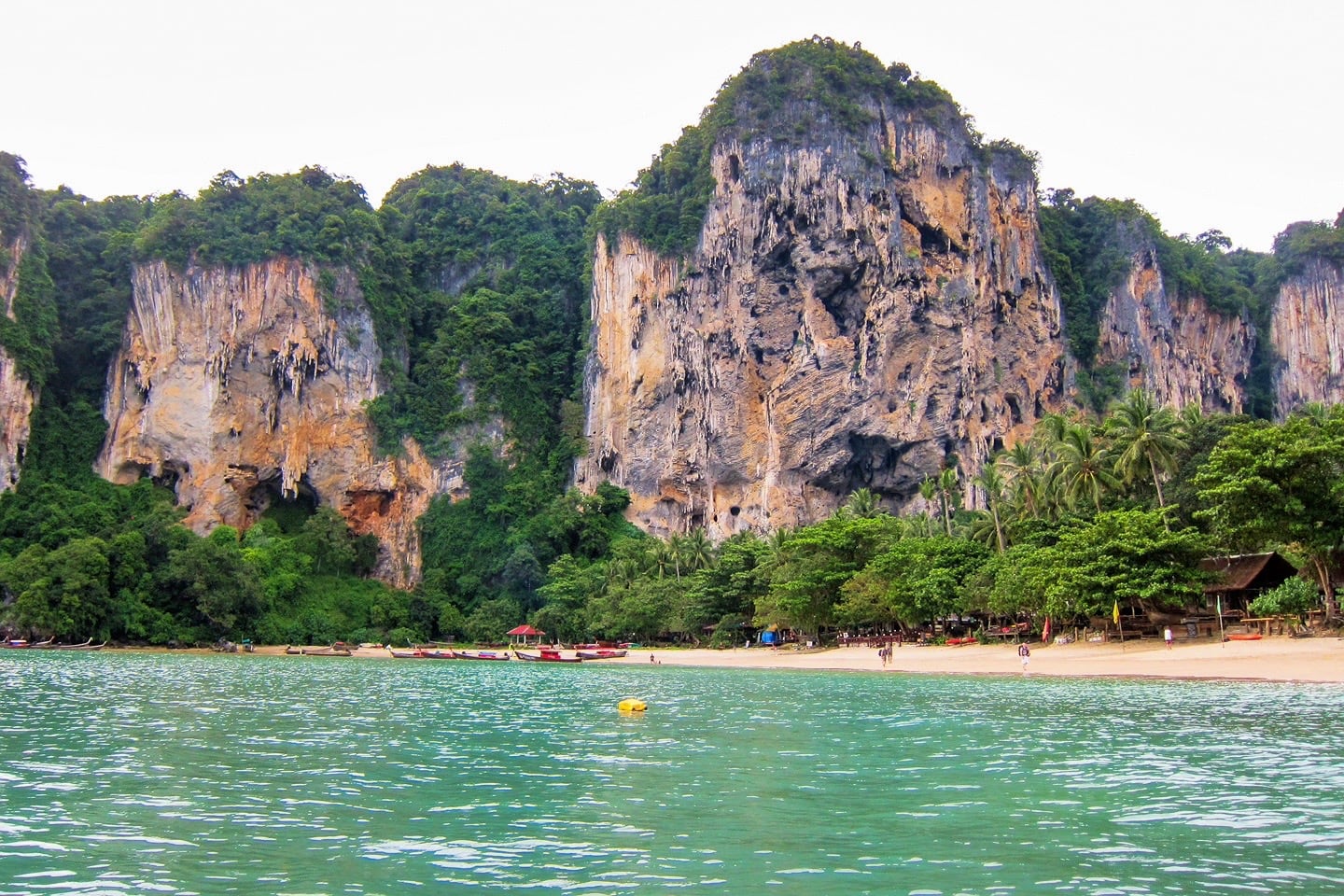
Ton Sai Beach
Finally, to the north of Railay West is Ton Sai beach, a nice palm-lined stretch of sand with a chilled out vibe but challenging to access—you’ll either have to scramble over a couple hundred meters of sharp rocks through a series of caves from Railay West, make your way via a jungle path over a hill from the highlands, or hire a longtail or kayak.
It appears you could probably swim there from Railway West, but that might not be the best idea due to strong surf and sharp rocks.
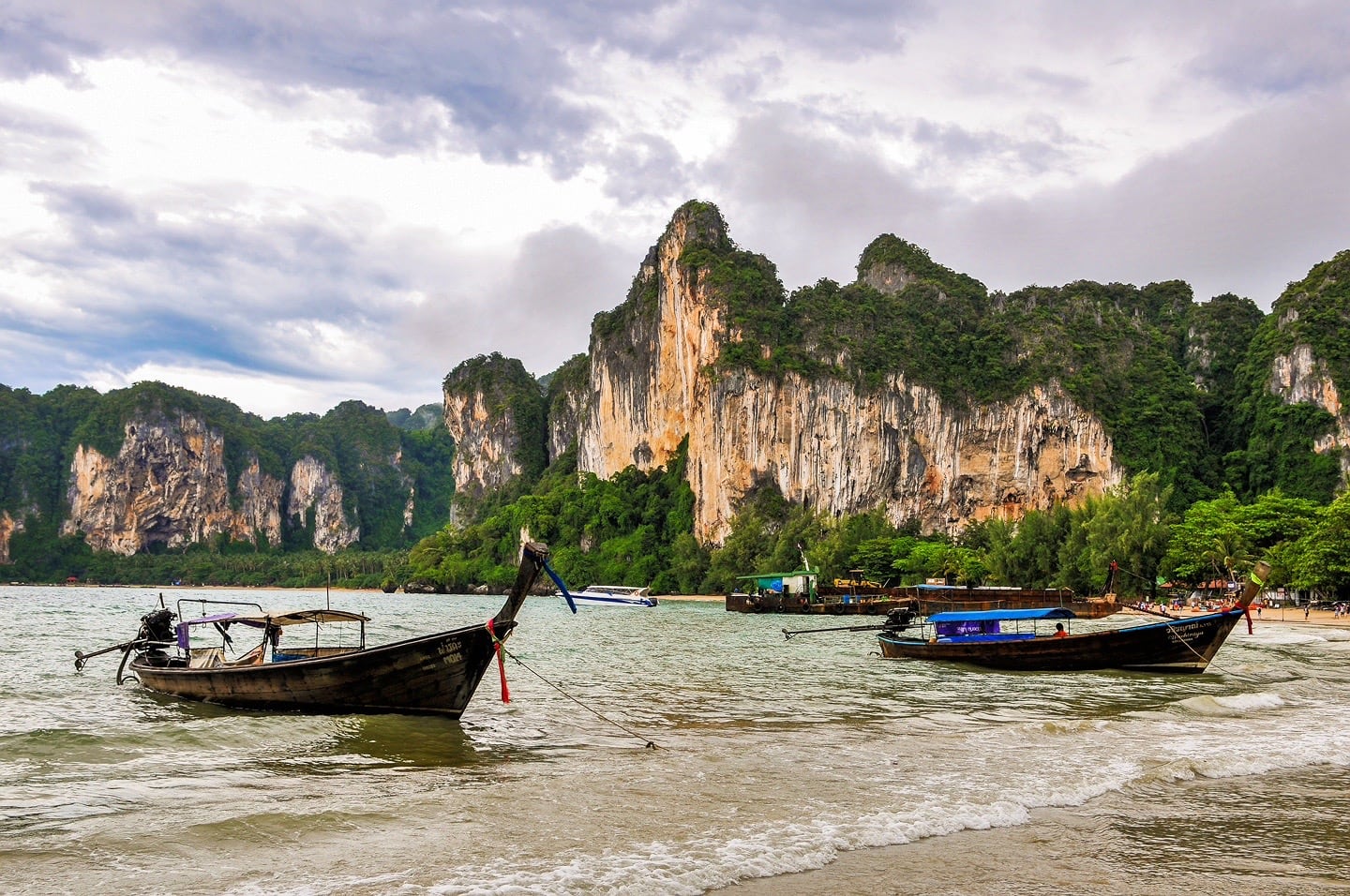
Getting to Railay from Krabi Town
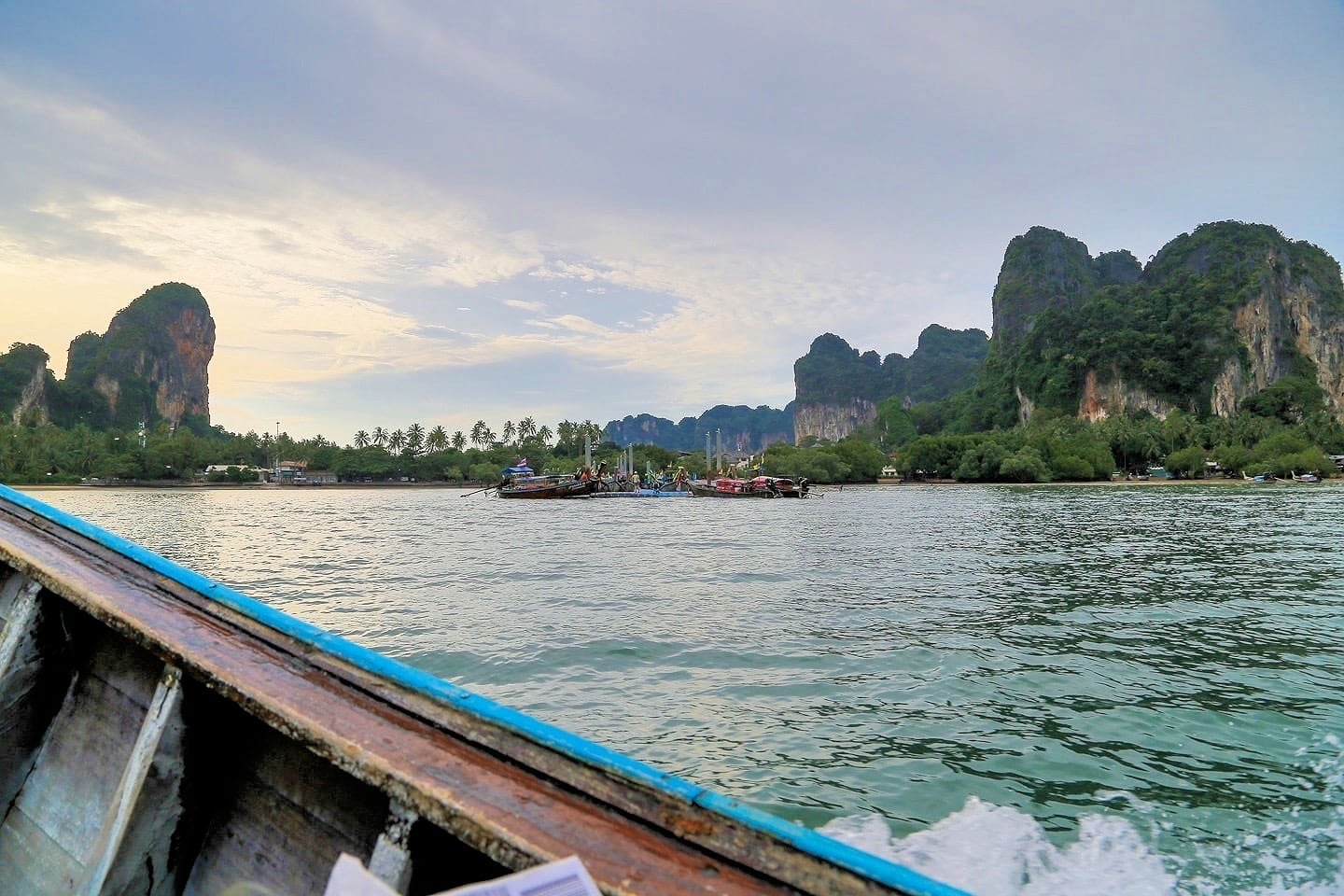
Independent Budget Traveler Method
On our first visit, we were on a shoestring budget and traveling as a couple. Arranging the boat from Krabi Town proved easy enough. We had breakfast at a cafe on the road to the pier (marked as ‘Pier to Railay’ on most maps).
On our way down, we were asked by a boatman whether we were going to Railay. He had a few passengers and would go when he had ten (we learned this was fairly standard).
There is a posted schedule (every two hours on the odd hour from 9am to 5pm, then a bonus trip at 6:30pm), but really they leave when they’re full.
As of mid-2024, the trip costs 100 baht each for locals and 200 baht for foreigners and takes about 25 minutes.
The boatmen seemed to be more legit and laid-back and the experience, more hassle-free, than most similar experiences we’ve had in Thailand.
It’s a beautiful ride out, usually on a covered boat, so if you head out there, make sure you have your camera ready to go!
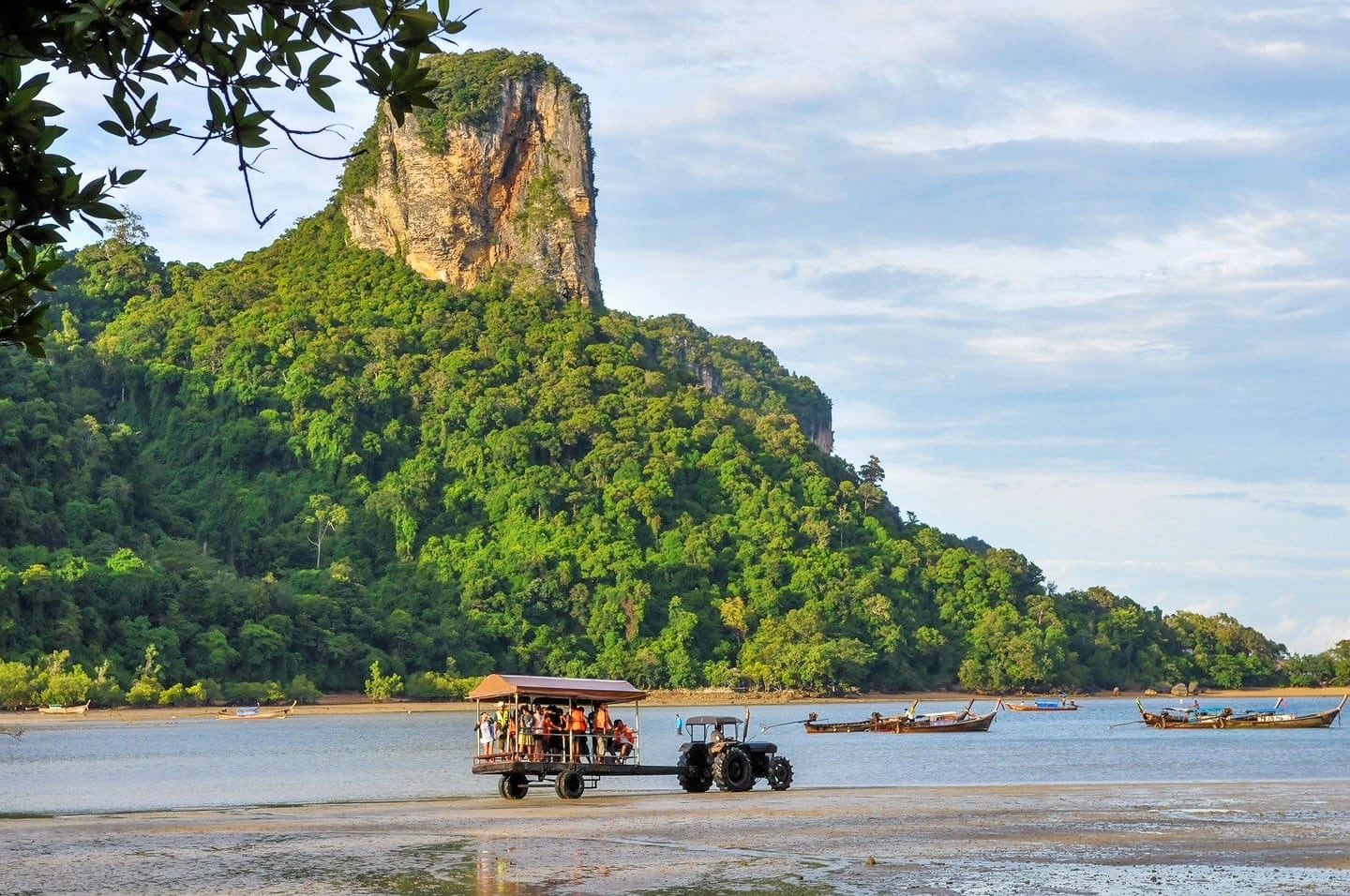
Keep in mind that you’ll need to hoof it (along with your pack and whatever else you’re arriving with) from the end of the floating dock on Railay East to your accommodation, which can be up to a kilometer (~1/2 mile) if you’re staying on Railay West or in the highlands.
Some hotels offer golf cart transfers but they will likely need to be arranged in advance.
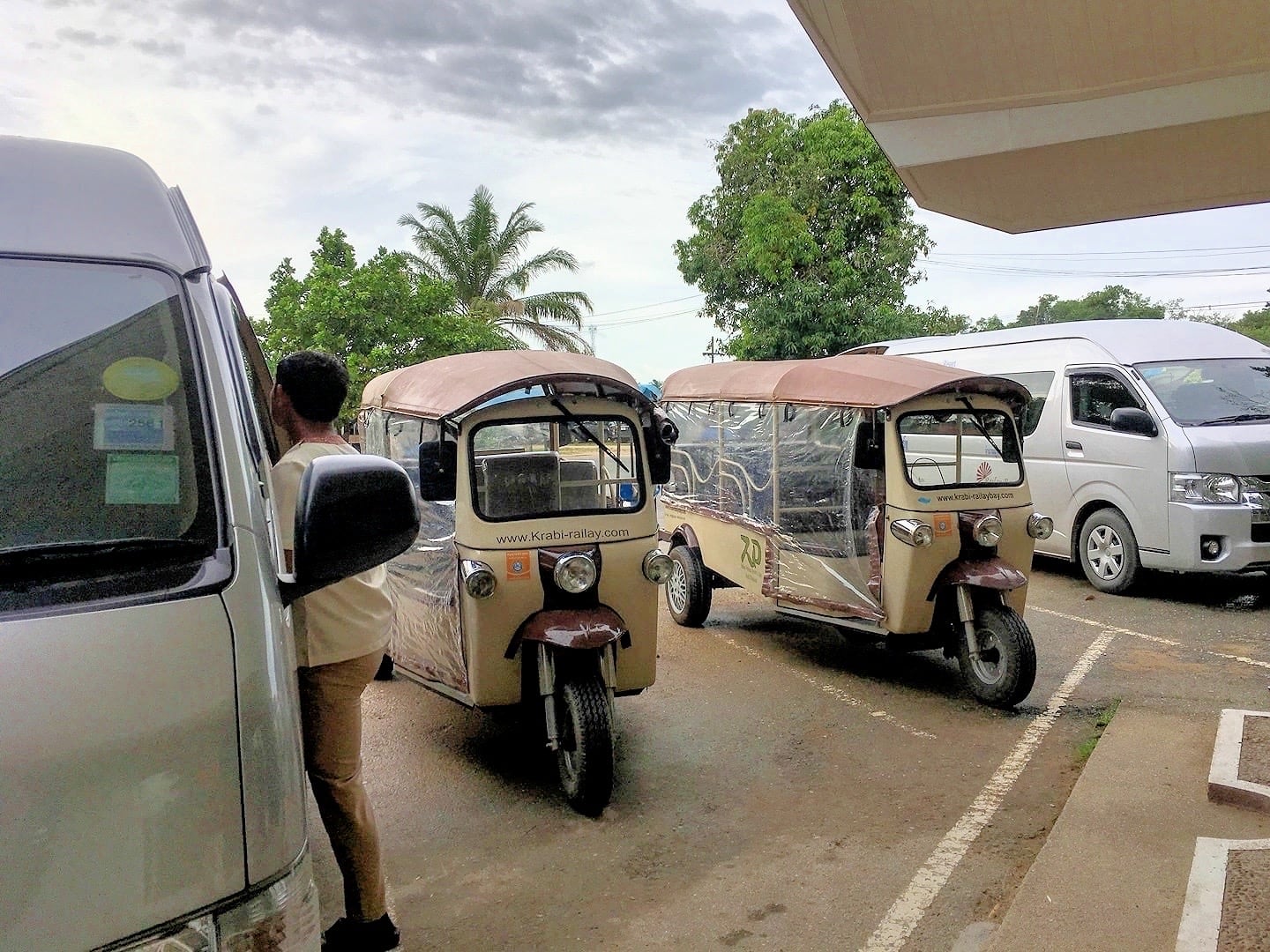
Joint-Ticket Mid-range Option from Krabi (KBV) Airport
On our second visit, we found ourselves traveling with a family entourage ranging from ages 18 months to 72 years. This time, we were also arriving at low tide. As a result, our airport transfer ended up including FIVE different vehicles, from the arrivals area at KBV to the reception desk at our hotel in Railay:
- Minivan from BKK to pier office (30 minutes);
- Tuk Tuk from pier office to end of pier/ boat (2 min.);
- Longtail boat from pier to Railay Beach East (20 min.);
- Tractor shuttle from boat to land at Railay East due to low tide (2 min.);
- And finally, golf cart from waterfront to front desk.
The service from the Krabi airport to our Railay hotel (door-to-door) cost about US$35 one-way total for the seven of us.
That’s actually a pretty great deal considering it would have cost nearly just as much to piece it all together ourselves.
Plus, we still would have had to walk our luggage nearly a half kilometer from the end of the Railay East pier to the front desk of our hotel.
Featured Things to See + Do
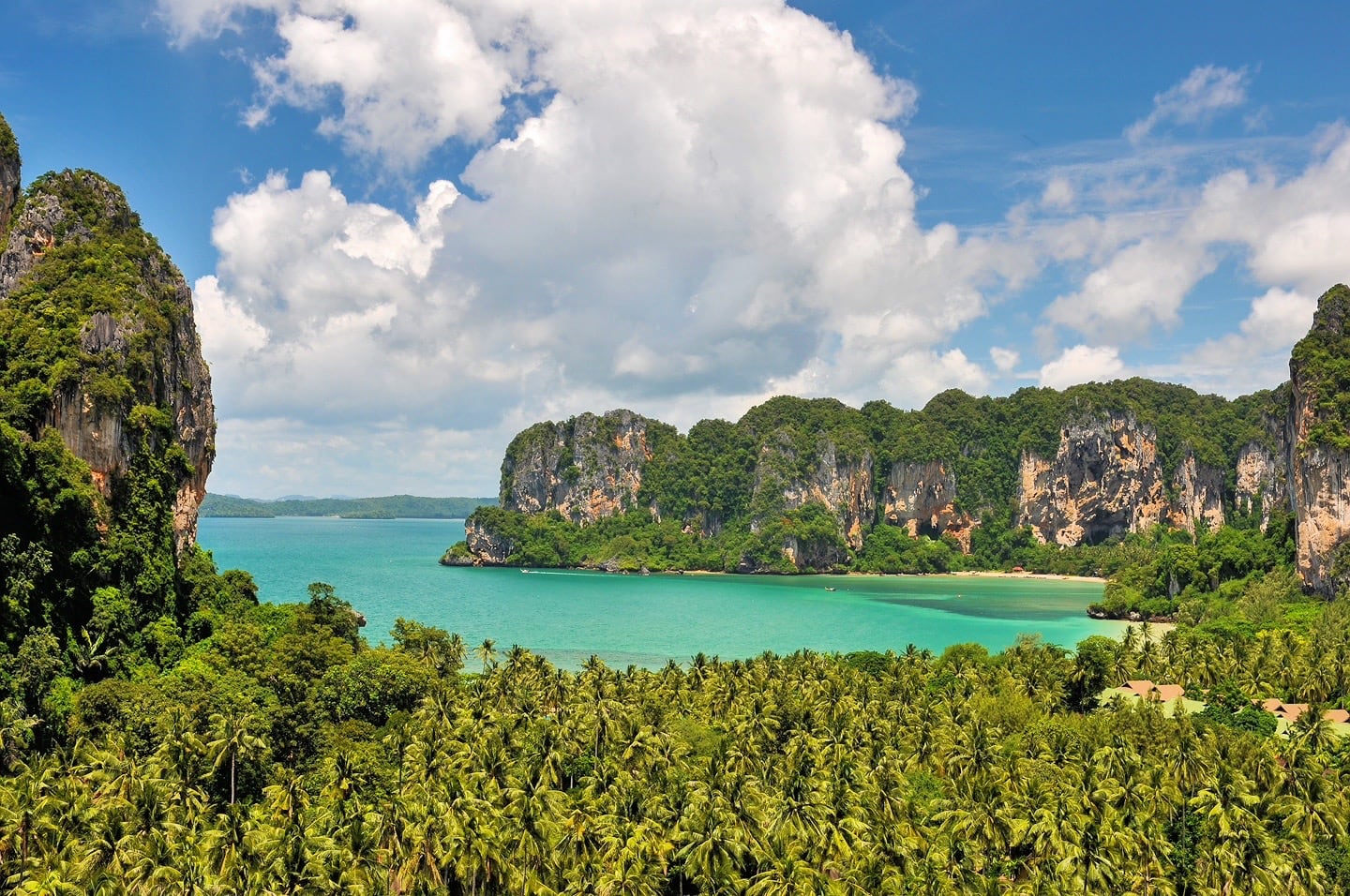
Hiking to the Viewpoint & Lagoon
If you walk south along Railay East (the mangrove side) down to the climbing wall where the monkeys scurry down the rock face and leap from tree to tree in the afternoon, you’ll come across a stone path that connects Railay East to the white sands beach of Princess Beach.
It’s a pretty cool path, hugging the sheer karst cliffs, winding through caves and frequented by more monkeys than you can shake a palm frond at.
About halfway down this path, Lori and I came upon a rustic shelter. On the shelter hung a sign with the words “viewpoint” and an arrow pointing over to a worn knotted rope leading straight up a rock face into thick jungle 30 feet above.
Now, who wouldn’t be intrigued by a random ratty rope disappearing high up into jungle in the tropics?
Later, we returned with hiking sandals and headed on up the rope, cause why not? We had been wearing flip-flops and thought they might not be the best footwear for scrambling up and over rocks, through jungle, you get the idea.
Some of the more chilled out rasta dudes we encountered along the way seemed to fair just fine leaping from rock to rock sans footwear in a state of zen. But we did see quite a few other hikers in flip-flops with gnarly gashes and scrapes from the trail.
The first part of the trail involves ascending with the assistance of a few different ropes. This section is pretty fun as long as there aren’t too many others going up or coming down as there’s room enough for one in each direction and it can take some time to negotiate.
Lori and I felt a bit weird coming to Railay, the climbing mecca of Thailand, without doing some climbing ourselves, so this was a good compromise for us.
After a while, you reach the top of the ridge, which is actually a small pass between two large karst peaks. At this point the trail splits—left to the viewpoint and right to the hidden lagoon. We opted for the viewpoint first.
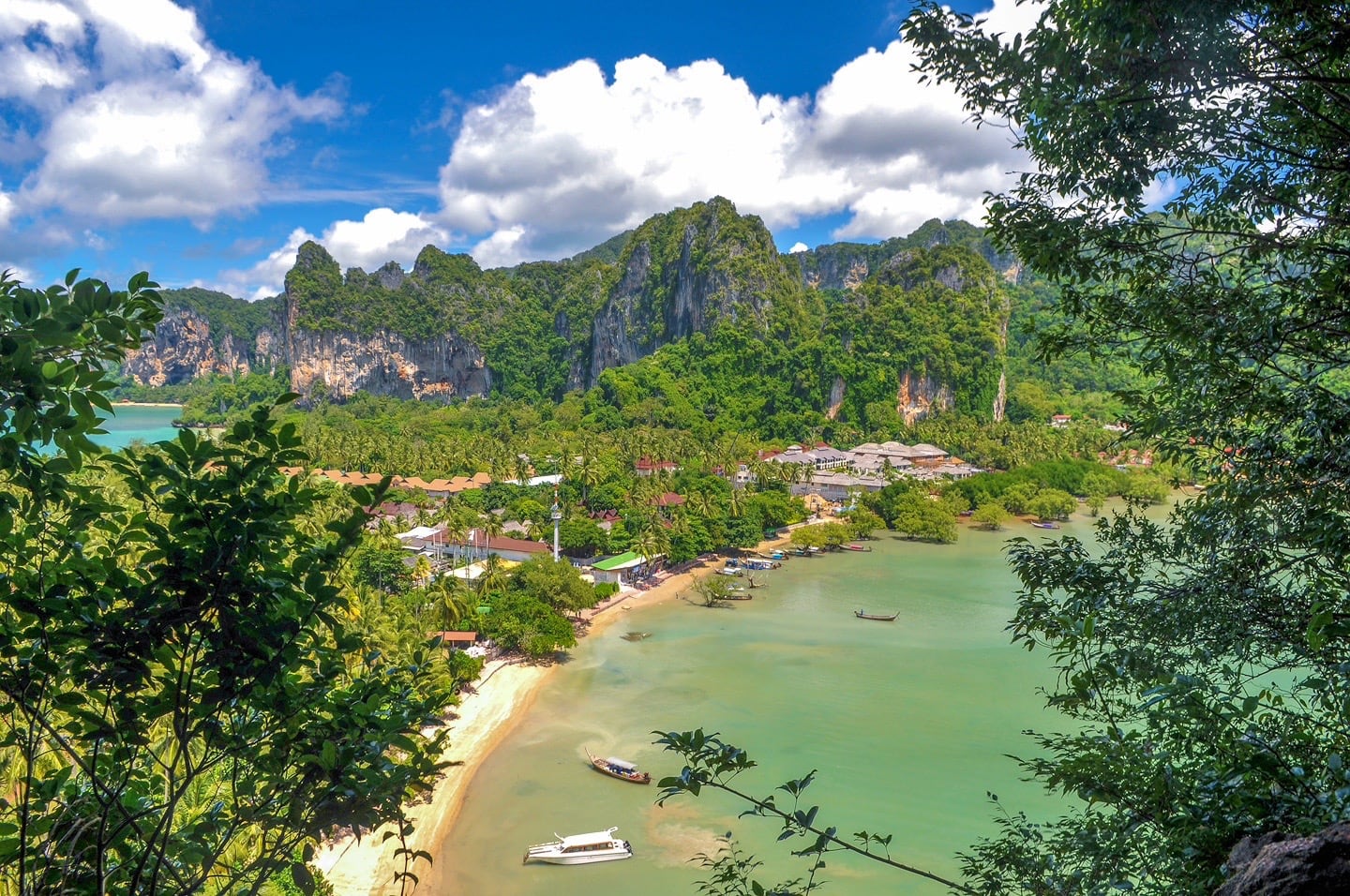
We continued on to the hidden lagoon. By this time, there were several other people descending the ropes that led into a dark, damp gorge with huge ceiba trees completely encircled by karst cliffs. It was very beautiful, but very slick and muddy here in the rainy season.
At the far end of the gorge, the trail dropped suddenly to the hidden lagoon far below. Everything was a slippery mess and the people coming up and going down this section were having a tough go of it.
We decided to save the hidden lagoon for another day and head back down for more beach time. Oh the tough decisions in paradise.
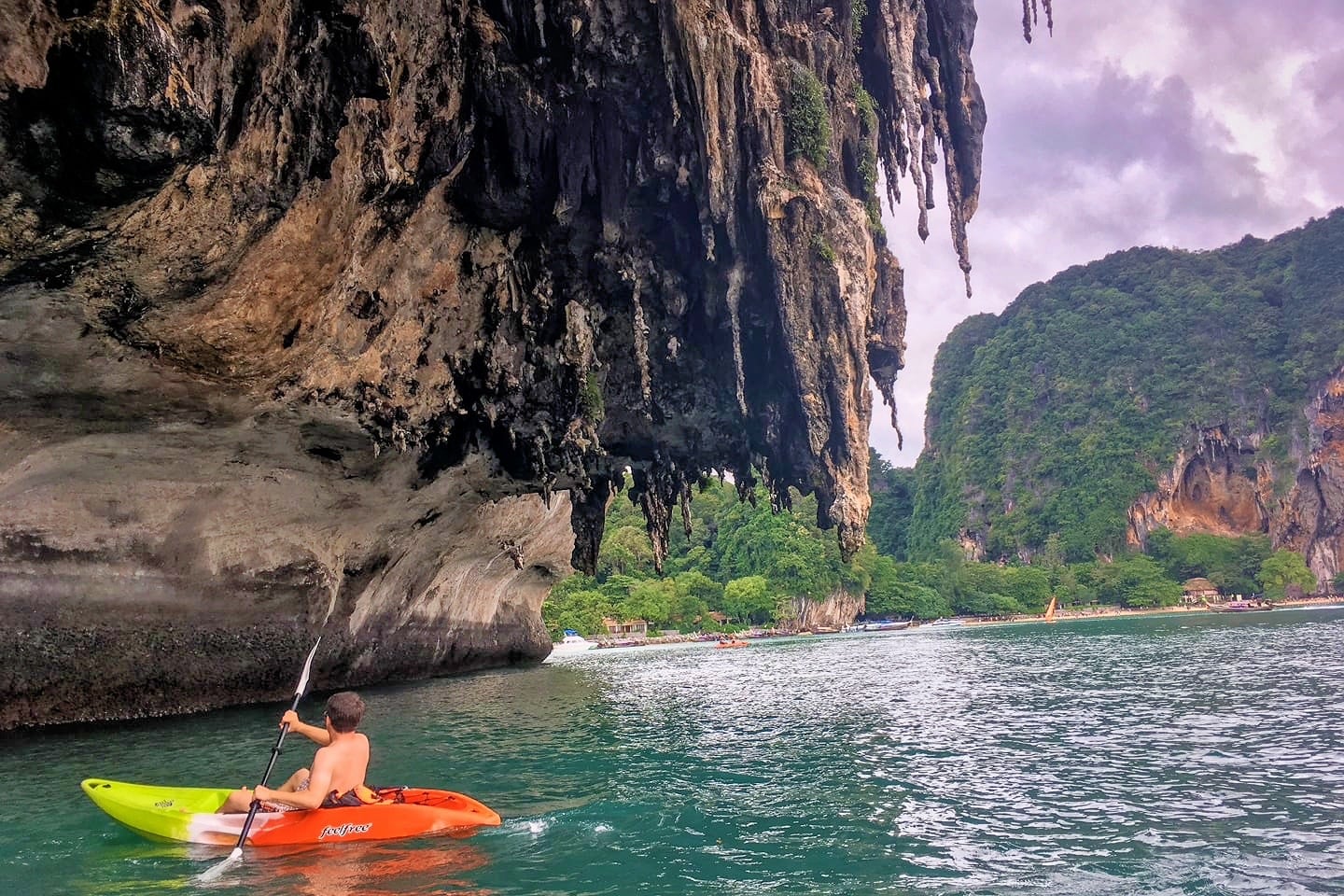
Kayaking
If (or when) you tire of the tough life of jungle hiking, chasing monkeys, and lounging on the perfect white sand beaches of Railay, there’s always kayaking.
For about $9 USD for two hours, you can rent a kayak from any number of vendors on Railay West and paddle around the peninsula.
We went out in the evening, hoping to catch one of the amazing sunsets we saw in previous evenings. Unfortunately, the overcast skies never cleared this particular evening, but it was a pleasant paddle nonetheless.
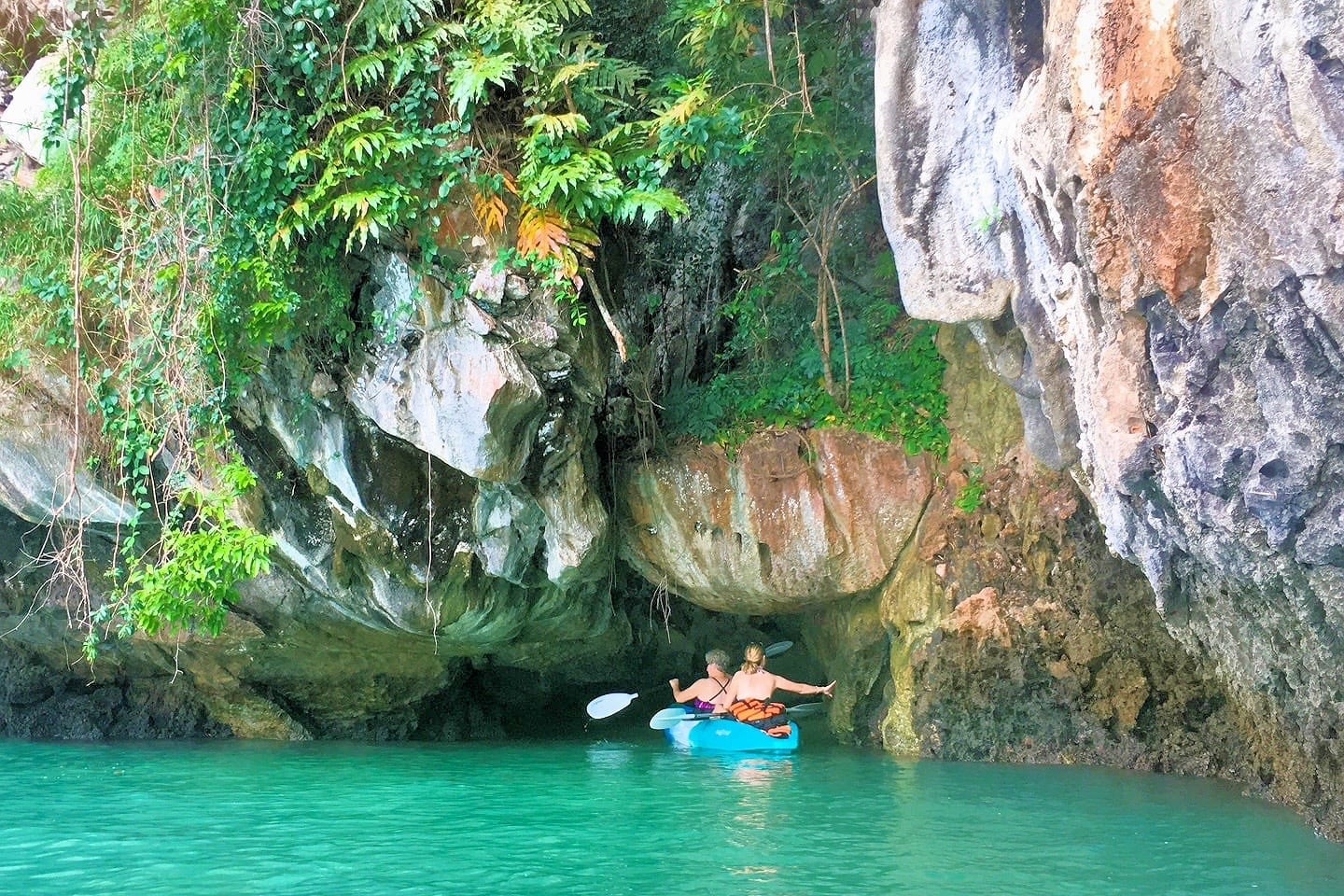
We started from Railay West, paddling into Ton Sai bay, then across Railay West bay and around the bend to Phra Nang.
We stopped for a while on the tiny beach of Koh Nok which is only exposed at low tied. On our way back, we paddled through the narrow gap separating Koh Nok and its sister island before returning to Railay West.
Along the way, there were plenty of interesting water caves to explore (some large enough to kayak through).
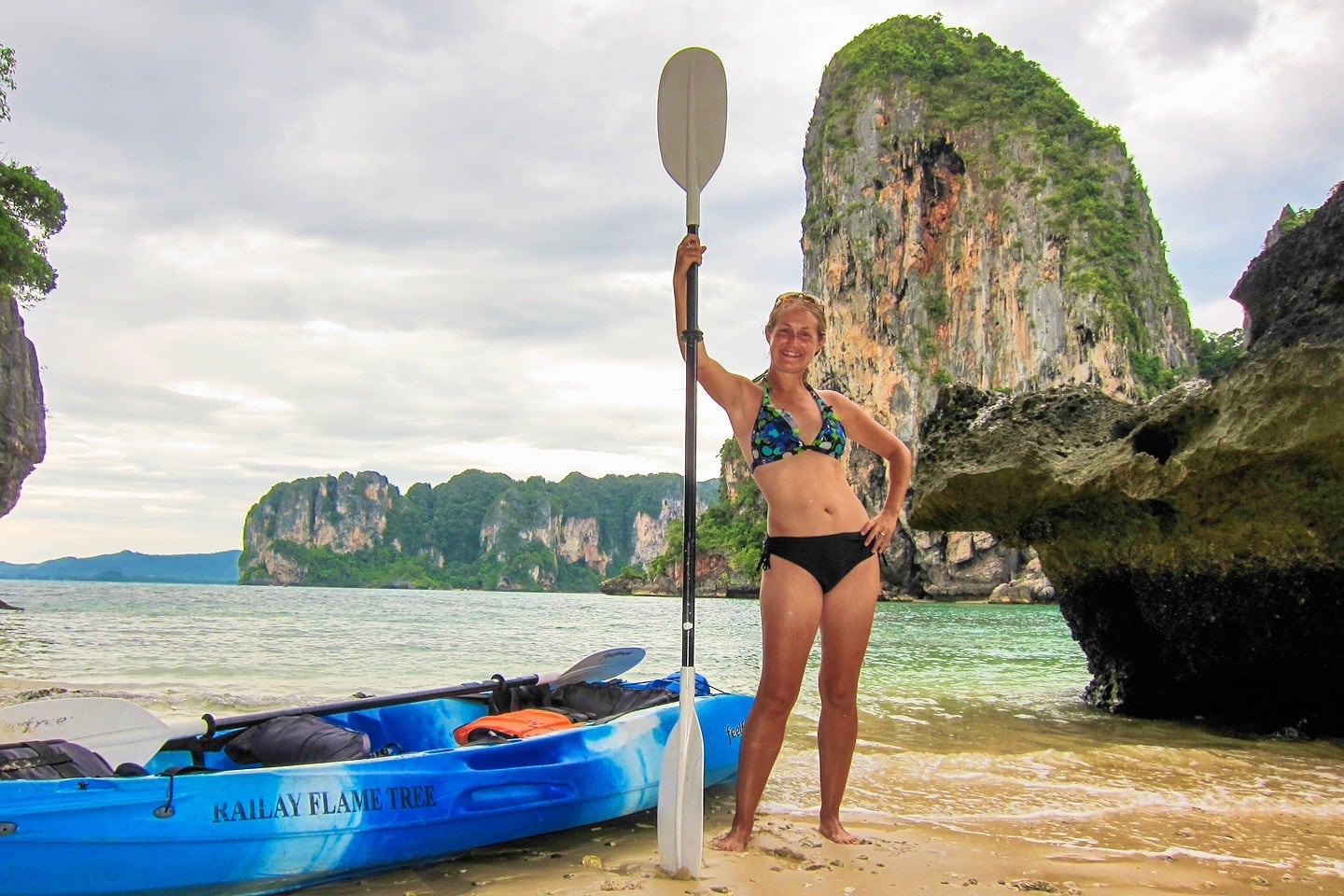
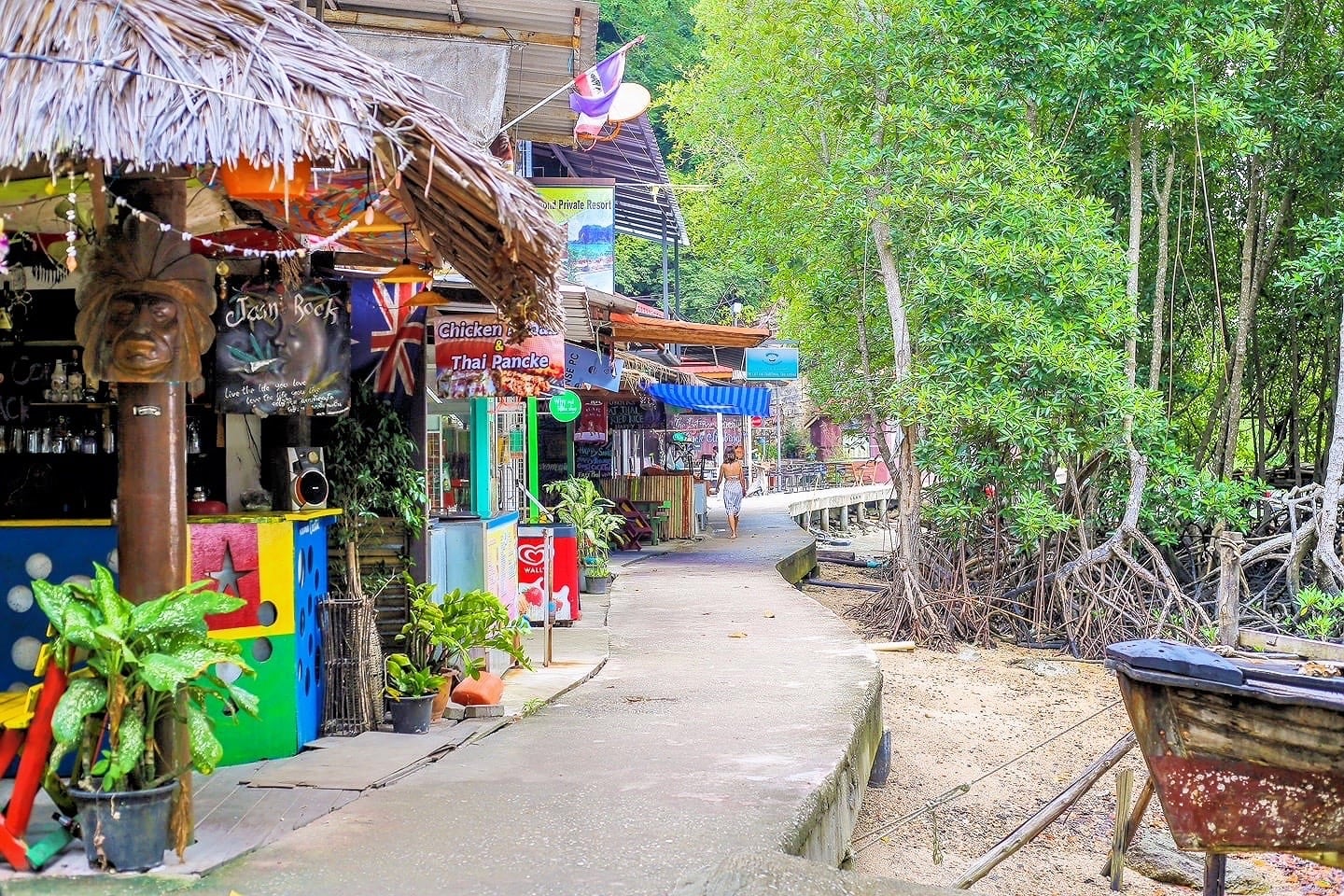
Footpath to Railay Great View Resort
We followed this path from Railay East to feed our curiosity and are glad we did. It’s a long walk to get to the hotel at the very end, and quite a nice little resort at that (with surprisingly many guests), but certainly very isolated with a 15-20 minute walk back into the village, and a 20-30 minute walk to the beach.
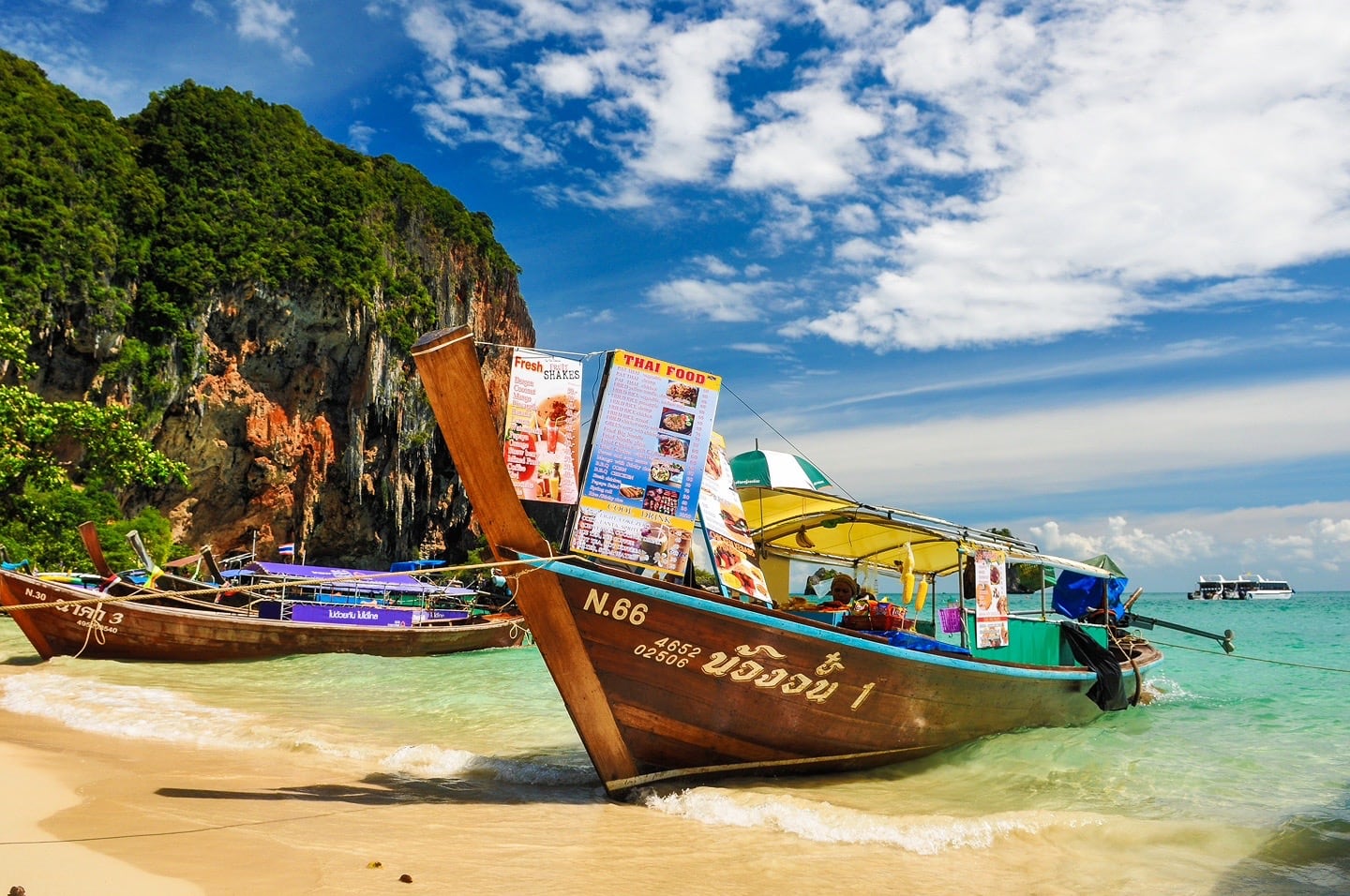
Phra Nang Boat Eats
Midday on Princess Beach (around the time that all the day trippers are descending on the peninsula), keep an eye out for the restaurant longtail boats at the far end of the beach. The boats serve everything from tasty Thai food to Western favorites like burgers, fries, and shakes.
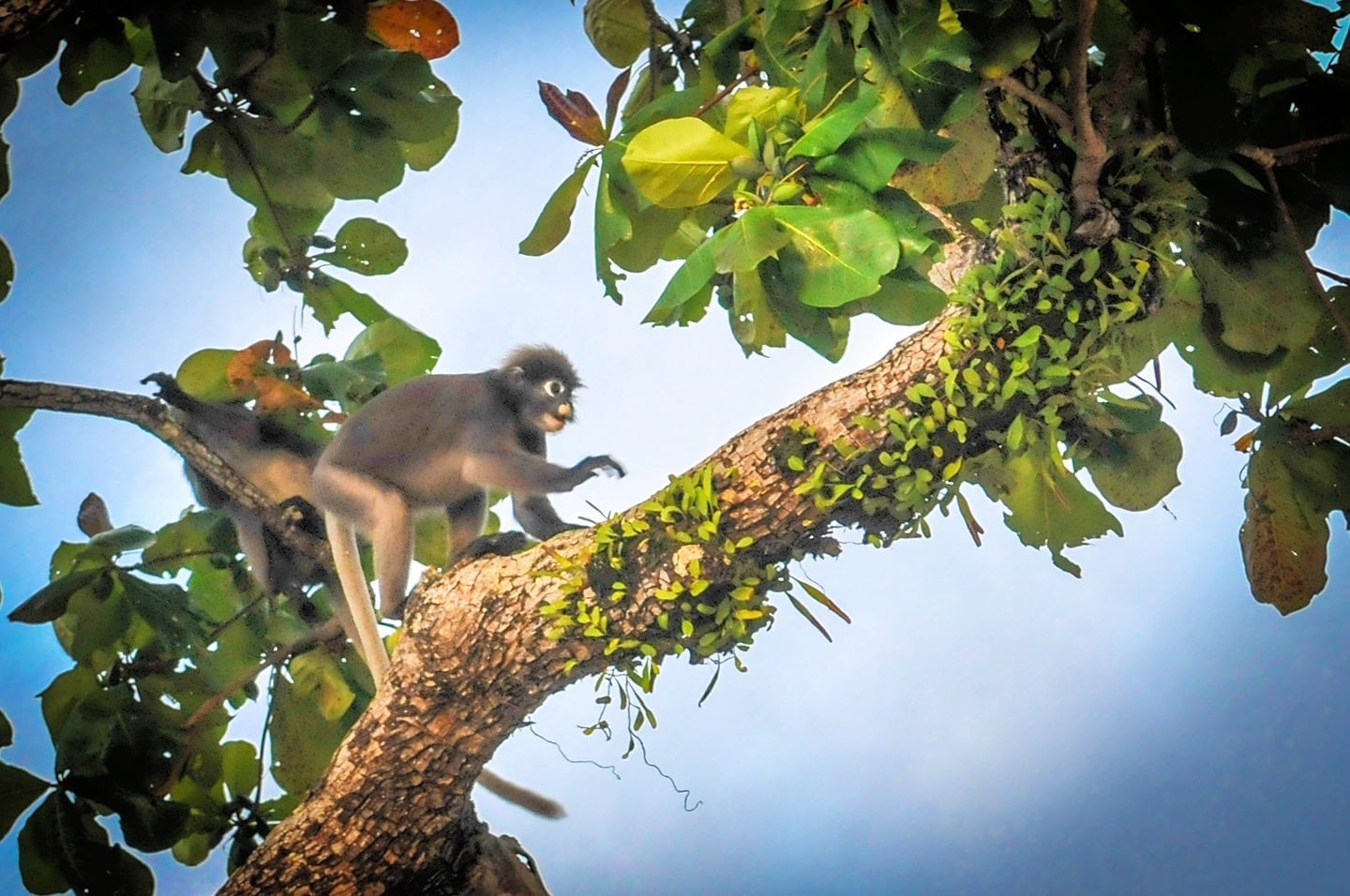
Monkeys!
If you like monkeys, then Railay is monkey heaven (and monkey hell for those of you who don’t).
Regardless of your feelings towards these wily jungle critters, they are EVERYWHERE on Railay and regard the peninsula as their territory.
Railay is home to two main types of monkeys, Spectacled Langurs (Dusky Leaf), and the more common ill-tempered and clepto-maniacal Macaque.
While you are more likely to find spectacled langurs leaping whimsically from tree to tree with the rest of their posse, the macaques are a different story.
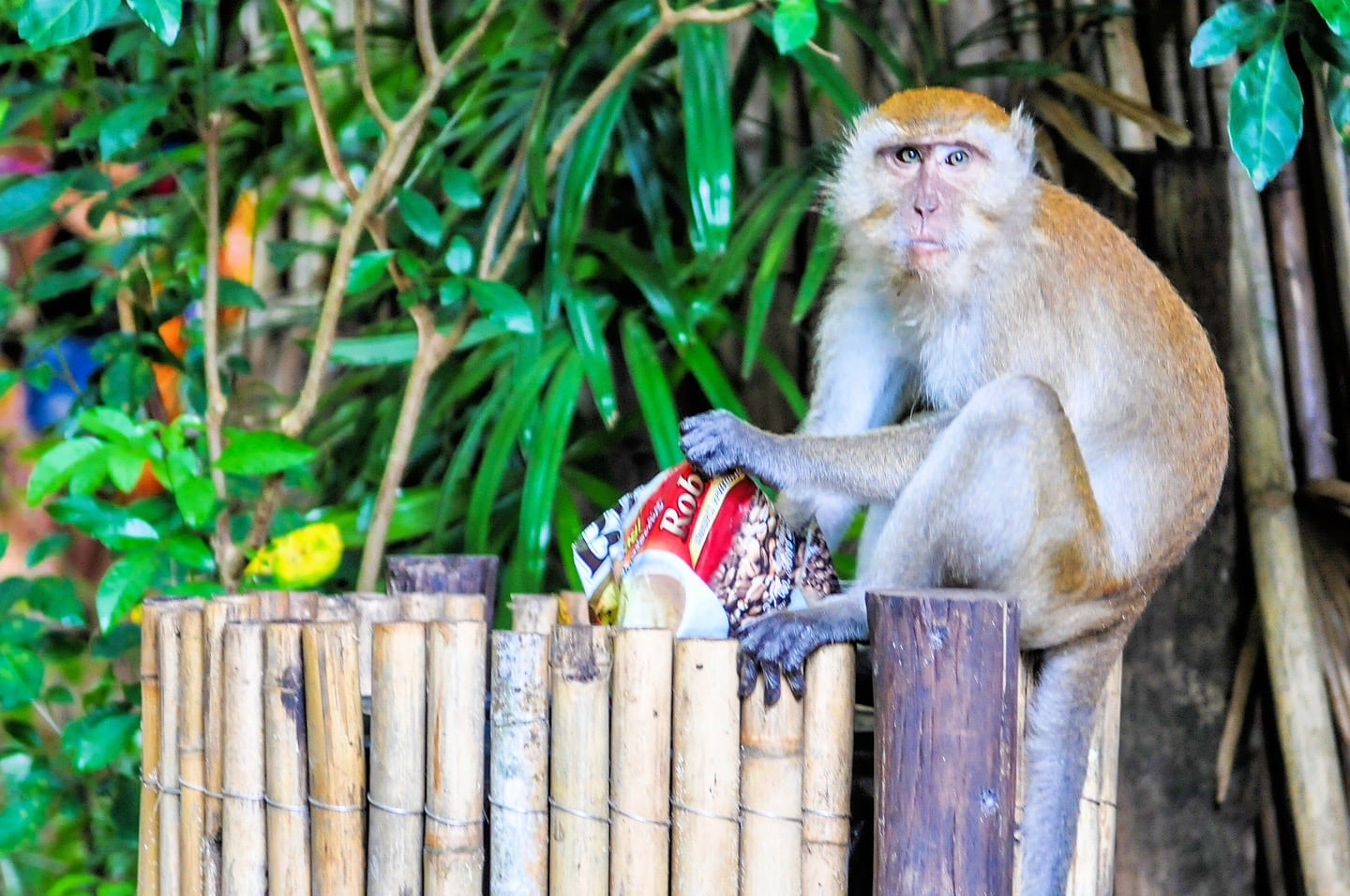
If you’ve ever spent any amount of time with a macaque, you’ll know that these dudes are vicious troublemakers. Favorite hobbies include rummaging through trashcans, stealing food, bags, purses, and really anything they can get their grubby little hands on—not to mention biting and scratching onlookers dumb enough to provoke these thuggish little fiends.
Especially on Phra Nang, keep an eye on your stuff, and don’t leave food out while you’re in the water.
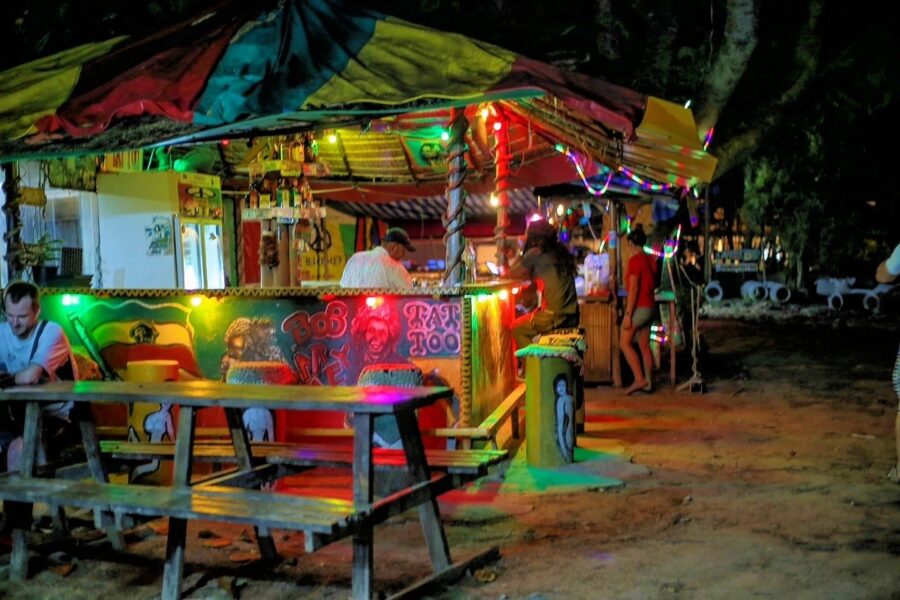
Railay Nightlife
The grey skies and afternoon showers may have thrown us off guard, but the evenings were about as perfect as you can get—low humidity and just warm enough to feel perfectly comfortable in shorts, a t-shirt, and sandals, which is a very good thing since I didn’t bother bringing anything else.
Railay isn’t exactly known for its nightlife, but that doesn’t mean there isn’t any. You won’t find full moon raves or wet t-shirt contests here. What you will find are a lot of people hanging out on the beach or at a reggae bar—beverage in hand—enjoying paradise and the relaxed vibe, which suits us just fine.
There are a few main areas to head to for nighttime fun on Railay: Railay Walking Street, Railay East Walking Alley, and Railay West Beach.
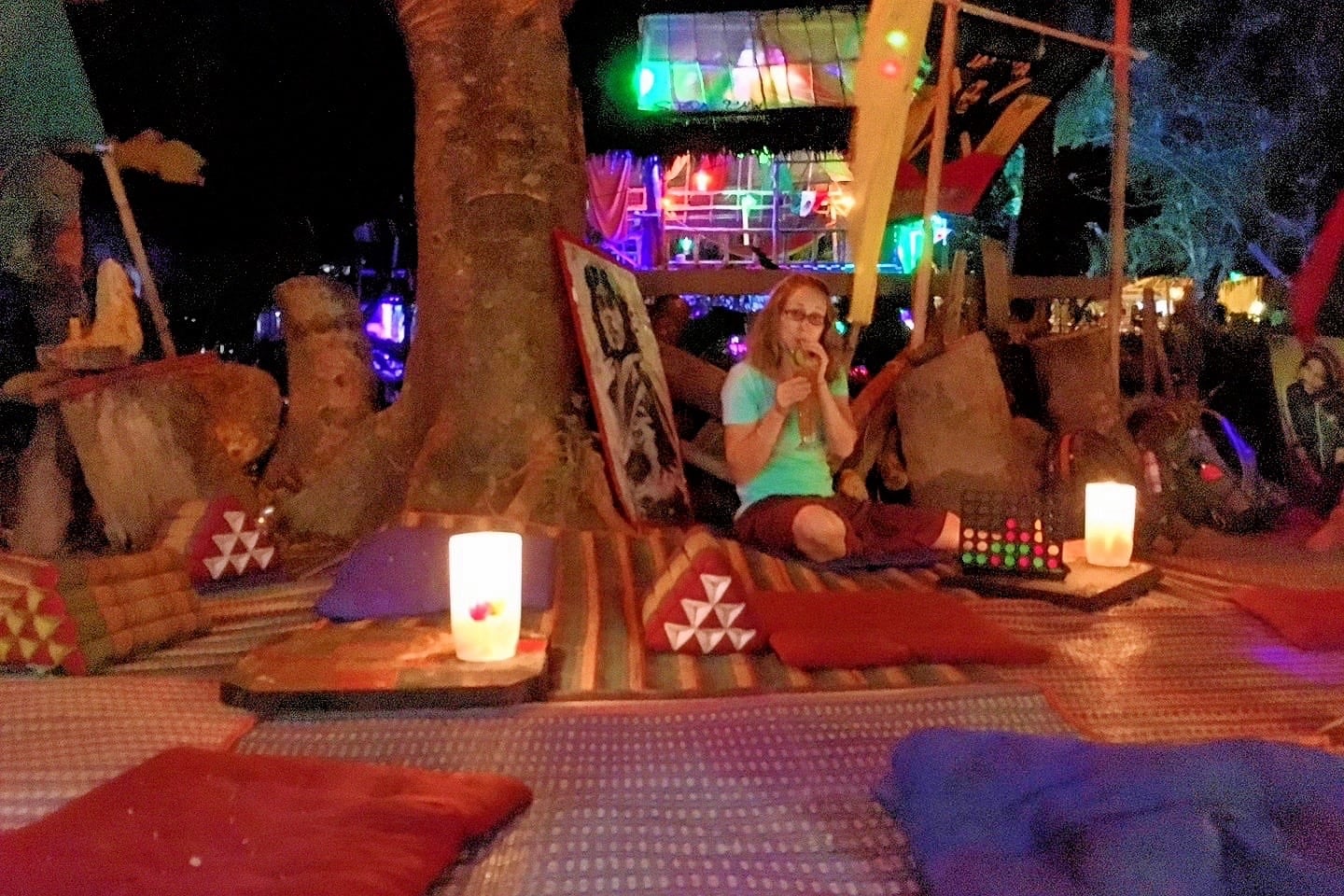
On our first visit to Railay, Railay Walking Street was nothing more than a jungle cut-through connecting Railay West and the highlands. By our second visit, it had become a full-fledged bar and restaurant strip. There are a handful of reggae bars and local restaurants that are worth checking out after the sun goes down.
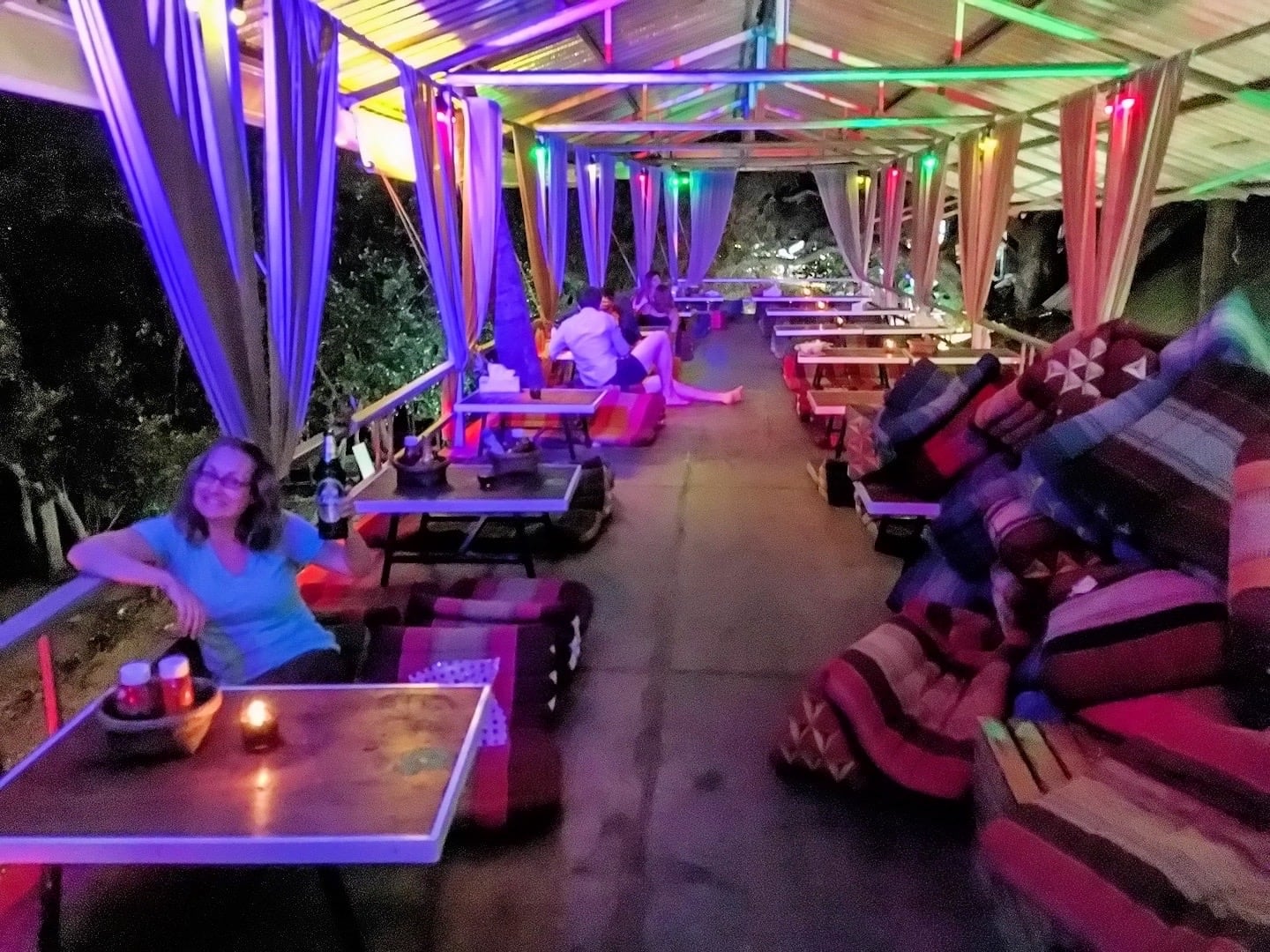
Railay East Walking Alley is the original nightlife spot on Railay. Here, you’ll find some of the cheapest drinks on the peninsula, Muay Thai, and a moonlit mangrove vibe.
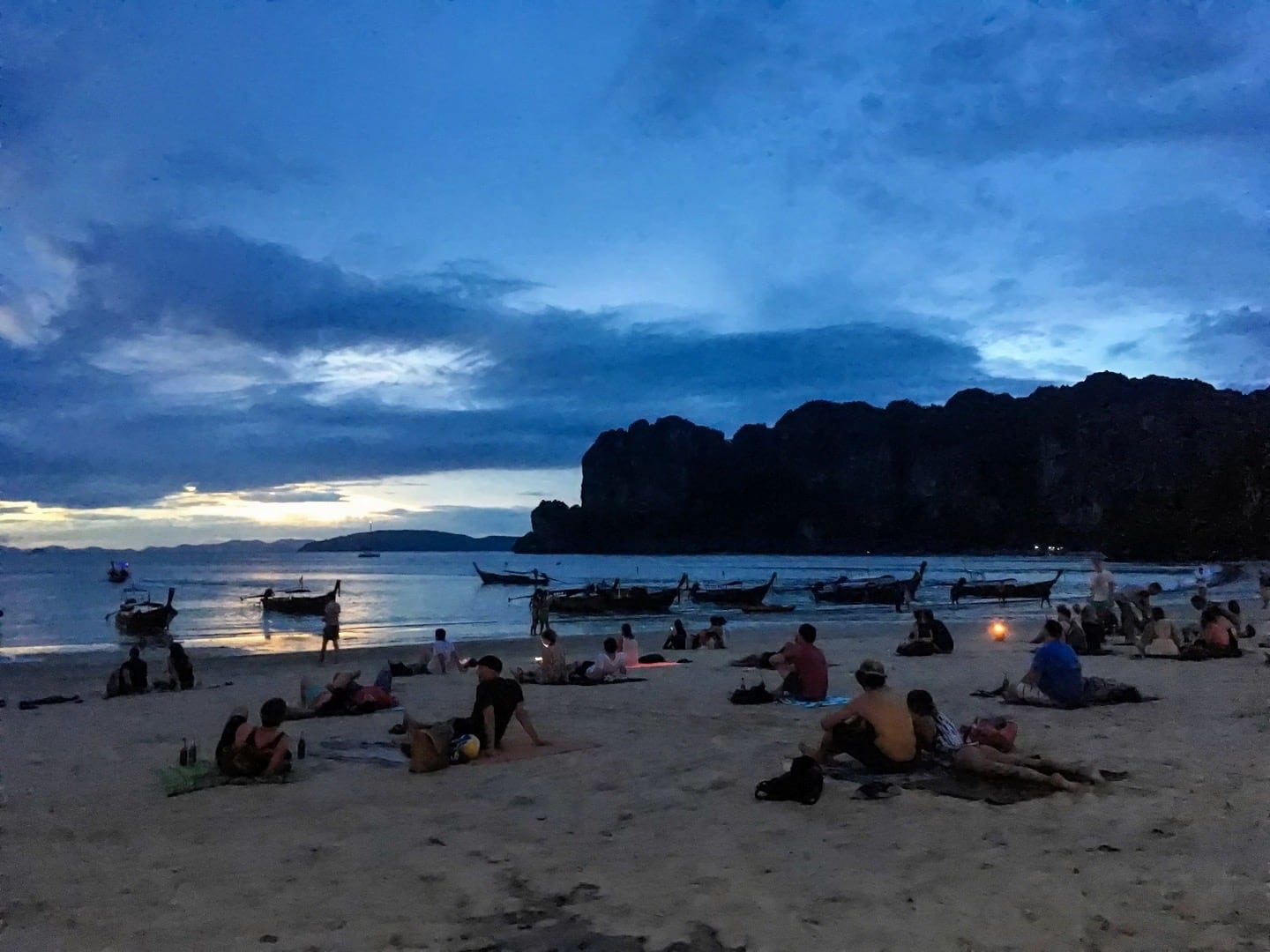
Of course, you can always just head to Railay West and chill out on the beach mat with a drink.
Railay Accommodation
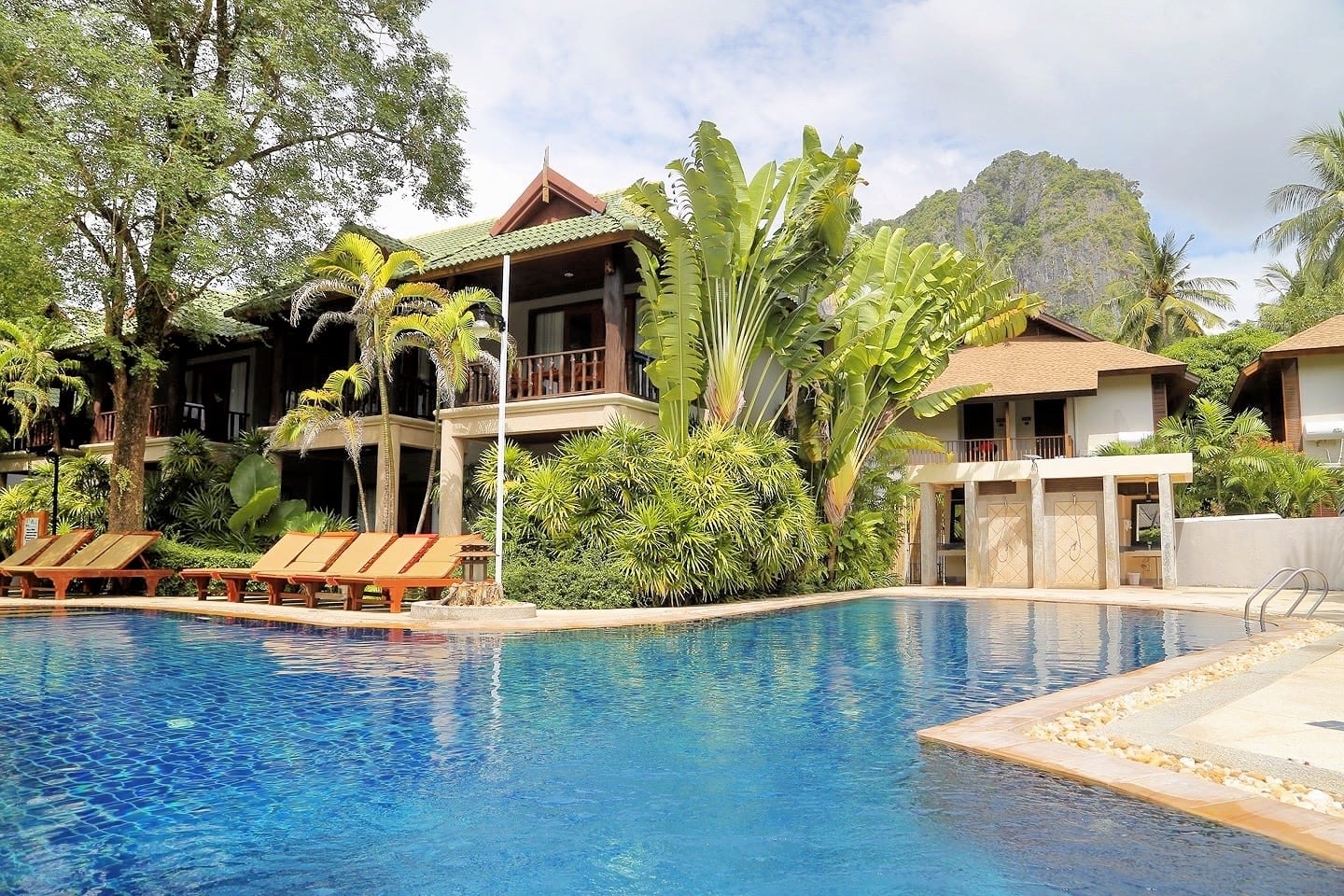
By Thailand beach standards, Railay is not cheap. But it is not crazy expensive either. While you won’t find US$15/night budget bungalows here, you do get a lot of value for the money.
Also worth remembering is that in terms of costs, the peninsula is practically an island, as everything has to be brought in by boat from Krabi town or Ao Nang. The vertical cliffs surrounding you on all sides also greatly limit space for new construction.
And, unlike many other beach locations in Thailand, there is not accommodation that directly fronts the water, which gives public beachgoers priority access to the water here in Railay.
On our first visit to Railay, we stayed at a nice little bungalow up in the highlands for about US$10/night. Since then, prices in general have risen and Railay’s gotten a bit more upmarket. Still, you can find basic accommodation on Ton Sai and the highlands for around US$25.
If you’re willing to pay a bit more, there are a number of excellent resort options on the peninsula, complete with swimming pools, beachside all-you-can-eat breakfast buffet, and other upmarket amenities.
Alternatively, nearby Ao Nang offers a lot of good budget accommodation, and Railay Beach West can be reached by a 10 minute long-tail boat ride from the Ao Nang pier.
With that said, nothing in the area compares to a stay on Railay proper, and if you can swing it, there are few better places in Thailand than Railay West or Phra Nang beaches to catch a beautiful sunset.
When to Visit Railay
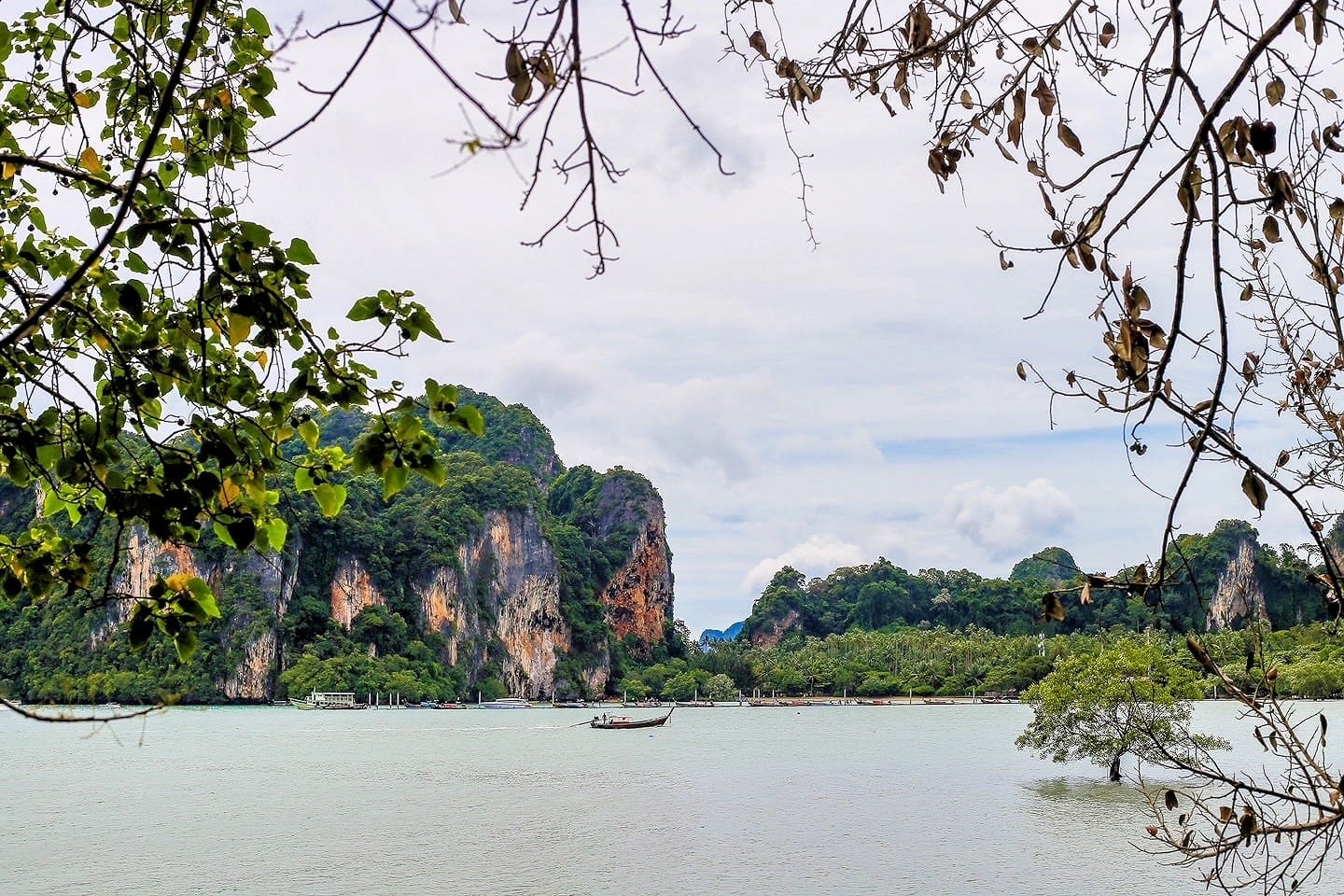
Everyone will tell you to visit Railay between November and March. It’s the dry season, after all. We think any time is a great time to visit Railay, and would even caution against visiting in the dry season. Here’s why.
For one, dry season coincides with high season. Unless you’re looking for the party (and higher hotel rates), you’re not necessarily going to get better weather going during this time. You will get crowds.
Our first visit was in mid to late October and the weather was superb. Sure, we got afternoon thunderstorms that dumped a ton of rain in a short period of time. But we also got sunny mornings and breathtaking sunsets. And much of the time, we had the peninsula to ourselves!
The second time we visited was in mid-December. We very rarely saw the sun (it was overcast almost the entire time), and YES it rained. Not torrential downpours, but enough. It was also pretty chilly in the evening, which we weren’t expecting either. And the crowds were about as bad as they get (the prices as well).
If you’re planning on traveling through Thailand and beach hopping on both sides, September-October is actually a nice time to visit. Start in the Gulf islands (Koh Tao/Phangan/Samui) until the weather starts to turn, then head to the Andaman Sea side where the weather is beginning to head into dry season.
Final Thoughts
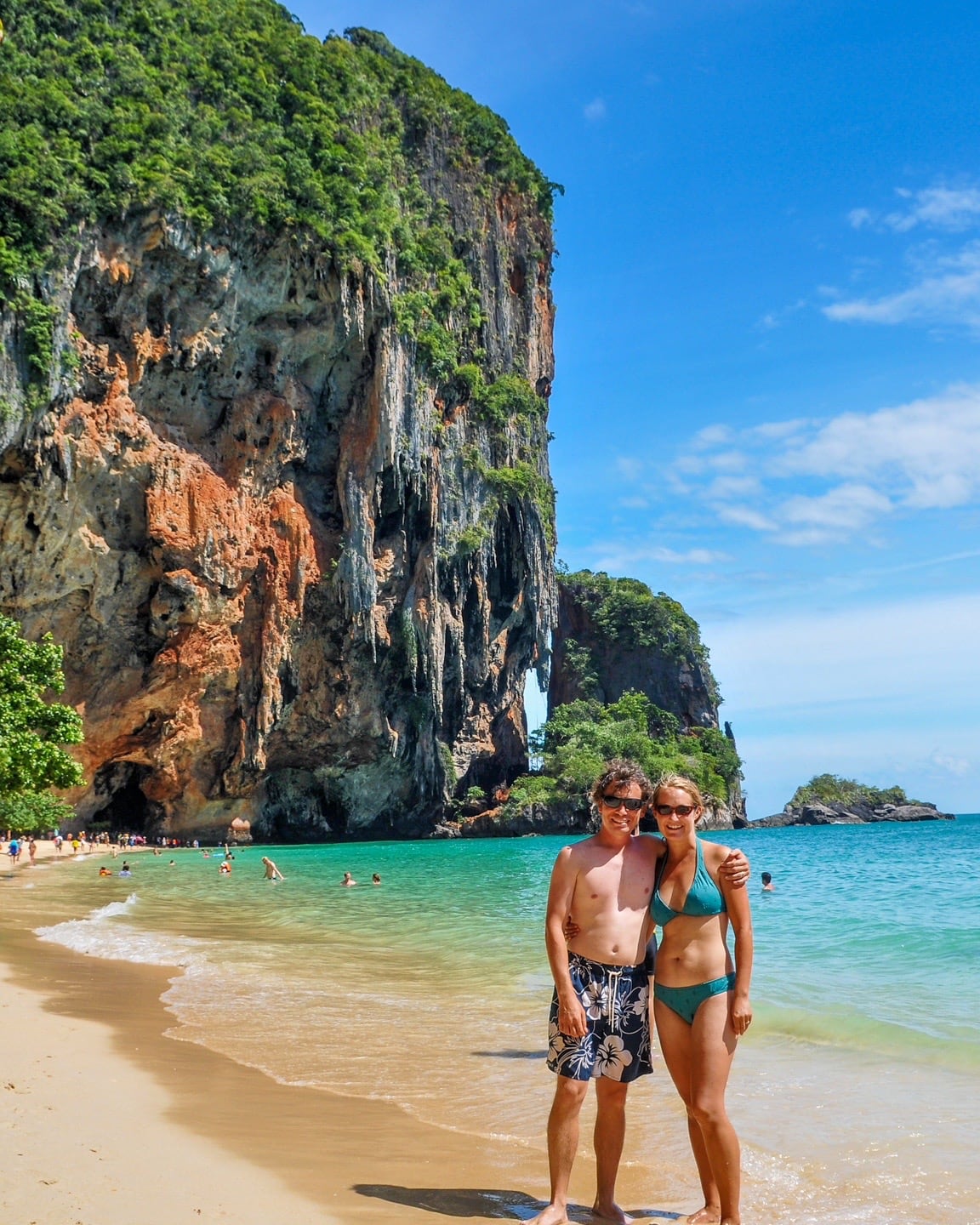
That’s our guide to Railay Beach and Peninsula. Is the most comprehensive guide you’ll ever encounter? Heck no. But we hope it gives you a different perspective on this amazing place than most guides will give you. We also hope you find some of these first-hand tips helpful in planning your own Railay Beach adventure!
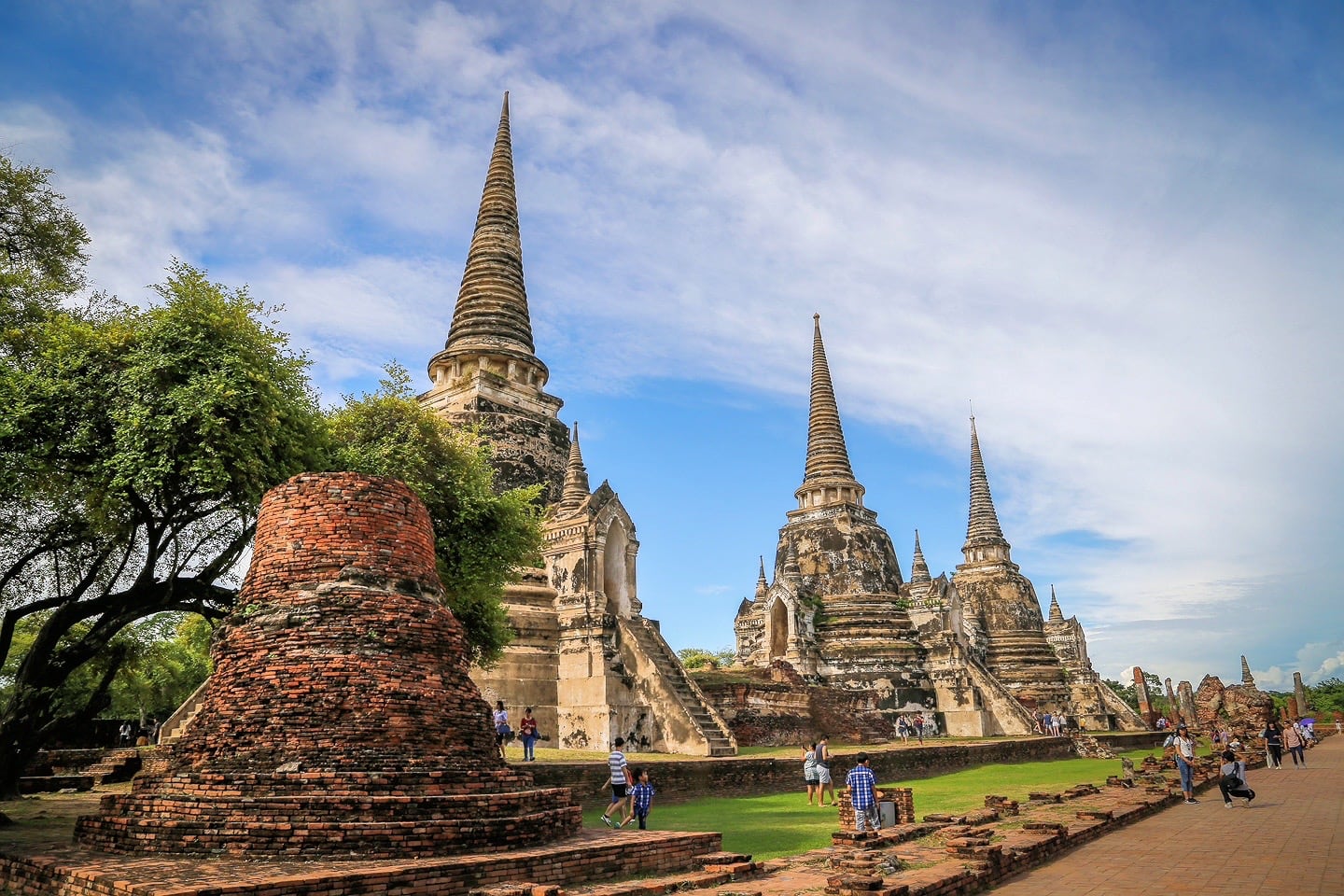
More Reading for Your Thailand Trip
Thailand Beaches
- Sairee Beach, Koh Tao: Visiting Thailand’s Diving Capital
- Chalok Baan Kao Bay: Koh Tao’s Chilled-Out South End
- Chaloklum Beach Koh Phangan: Guide for Travelers
- Night Ferry from Chumphon to Koh Tao: Detailed Guide
Around Thailand